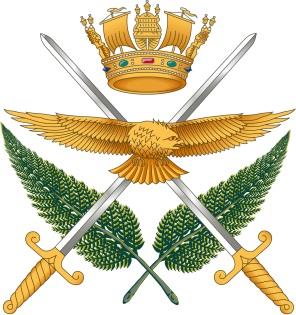 NZDF Output Plan
FY 2021/22
Releasable to the public pursuant to section 22 of the Official Information Act 1982.
©Crown Copyright [2021]. This document is the property of the New Zealand Defence Force.
The text in this document may be reproduced for use by members of the New Zealand Defence Force.
Crown Copyright material must not be used or reproduced for any other purpose without prior
permission of the Chief of Defence Force.
NZDF Output Plan
FY 2021/22
Releasable to the public pursuant to section 22 of the Official Information Act 1982.
©Crown Copyright [2021]. This document is the property of the New Zealand Defence Force.
The text in this document may be reproduced for use by members of the New Zealand Defence Force.
Crown Copyright material must not be used or reproduced for any other purpose without prior
permission of the Chief of Defence Force.
Chief of Defence Force
Headquarters New Zealand Defence Force
WELLINGTON
RELEASED UNDER THE
OFFICIAL INFORMATION ACT 1982
CONTENTS
NZDF Output Plan 2021/22
Chief of Defence Force Direction to the NZDF
2
Managing Outputs
5
Readiness for contingent military operations
5
Master Activity Schedule
5
Managing and reporting of readiness
6
Quarterly Reports
6
Risk
6
Summary of Output Appropriations
7
Variations to the 2020/21 Output Plan for FY 2021/22
7
Output Structure FY 2021/22
9
Summary of Defence Force outputs to be delivered and allocation of funds 10
Output Categories 1 – 3: Prepared
11
Output 1: Navy Capabilities
12
Output 2: Army Capabilities
16
Output 3: Air Force Capabilities
24
Output 4: Protect
27
Output 4.1: Resource and Border Protection Operations
28
Output 4.2: Defence International Engagement
32
Output 4.3: Assistance to the Civil Power and Provision of a Public Service in
Emergency Situations
36
Output 4.4: Military Assistance to Civil Authorities in Non-Emergency Situations
44
Output 4.5: Defence Support to the Community
46
Output 5: Project
49
Output 5.1: Military Operations in Support of a Rules-Based International Order
51
Output 5.2: Military Operations that Contribute to Regional Security
53
Output 6: Inform
55
Output 6.1: Policy Advice
56
Output 6.2: Situational Awareness
57
Output 6.3: Supporting Ministers
58
Output 7: Supporting Our Veterans
60
Annex A: Output Performance Specifications (Only available on SIE)
I
RELEASED UNDER THE OFFICIAL INFORMATION ACT 1982
NZDF OUTPUT PLAN 2021/22
Chief of Defence Force Direction to the Defence Force
1.
These general orders are issued and promulgated pursuant to Section 100 of the
Defence Act 1990. They provide for the correct and proper delivery of New Zealand Defence
Force (NZDF) outputs for FY 2021/22.
2.
As the Chief of Defence Force, I am accountable to Parliament for ensuring the
delivery of NZDF outputs and the expenditure of public money is managed correctly and
efficiently.
3.
The Government expects the NZDF to contribute to all-of-government efforts to
secure New Zealand against external threat, to protect our sovereign interests, including in
the Exclusive Economic Zone (EEZ), the Extended Continental Shelf (ECS) and those states for
which New Zealand has constitutional responsibilities.1 The NZDF must also be prepared to
meet likely contingencies in our strategic area of interest, and respond to internal
contingencies such as pandemics.
4.
The Output Plan provides a robust means of managing and reporting performance
to assure the Government and the New Zealand public that the NZDF is delivering outputs to
expected standards and within the limits of the resources provided.
5.
Our outputs are focused on the NZDF’s core responsibility: to be successful in
operations, while ensuring affordability and preparing for future operational challenges.
6.
The NZDF is supporting the Government’s response to the current global
pandemic, deploying approximately 1,300 people. This is the largest military commitment
since Timor-Leste in 1999, and it is expected to last until at least mid 2022. The combined
effects of the pandemic and Op PROTECT are inhibiting training to prepare military
capabilities for other operations resulting in a regeneration effort that could be as long as
three years, particularly for Army.
7.
On 20 May and 29 Jun 2021, I advised the Minister of Defence that the overall
ability of the NZDF to provide certain outputs is expected to reduce over time. The
combination of Op PROTECT, increased maintenance for ageing platforms, the timing of
some capability programmes and operational release of platforms, means that some
capabilities will be either unavailable, or available only in restricted form throughout FY
2021/22.
8.
Activities are to be continually reviewed to minimise impacts as much as possible.
Where delivery of outputs is likely to fall below directed levels, the impact (both in-year and
out-years) is to be reported to me without delay. Impact reports are to include the
following:
a.
an assessment of the most likely missions to which a response could be provided
and sustained, noting the Government’s priority for support operations in the
South West Pacific region;
b.
changes to response times, sustainability requirements and concurrency
considerations (including the ability to provide essential military capability within
New Zealand if forces are deployed); and
1 Cook Islands, Tokelau and Niue
2
RELEASED UNDER THE OFFICIAL INFORMATION ACT 1982
c.
the resources and activities required to regenerate readiness, noting that
additional funding will not necessarily improve response times.
9.
All activities that generate outputs must be judiciously controlled, prioritised and only
conducted where funding has been allocated and remains available.
10. Variations to the standard performance measures for FY 2021/22 are detailed in the
table for each output class.
Accountabilities
11. Chiefs of Service and the Commander Joint Forces New Zealand (COMJFNZ) are
accountable to me for the delivery of their Outputs, while other commanders and senior
executives are accountable to me for supporting the delivery of the prescribed outputs and
remaining within their allocated funding envelope; specifically:
a.
The Chief of Navy is accountable to me for the delivery of Output 1 and
supporting the delivery of all other outputs in this plan, where appropriate;
b.
The Chief of Army is accountable to me for the delivery of Output 2 and
supporting the delivery of all other outputs in this plan, where appropriate;
c.
The Chief of Air Force is accountable to me for the delivery of Output 3 and
supporting the delivery of all other outputs in this plan, where appropriate;
d.
COMJFNZ is accountable to me for the delivery of:
(i)
those specific tasks and activities of Output 4 assigned to COMJFNZ;
(ii) deployed operations conducted under Output 5 where operational
command has been assigned to COMJFNZ;
(iii) supporting the delivery of all other outputs in this plan, where directed;
and
(iv) informing those government agencies supported by the Defence Force of
the resources and capabilities that may be made available for tasks under
Output Four.
e. The accountability for the delivery of Output 6 rests with:
(i) the Chief of Staff, HQNZDF for the delivery of Output 6.1 (in concert with
MoD) and 6.3; and
(ii) the Chief Defence Intelligence for the delivery of Output 6.2.
f. The Chief People Officer is accountable to me for the delivery of Output 7.
12. Senior NZDF executives with portfolio responsibilities are accountable to me for
supporting the delivery of all NZDF Outputs specified in this Plan and must make every
endeavour to ensure that the NZDF meets its obligations.
Output Plan
13. The Output Plan 2021/22 implements the Government’s requirement of the Defence
Force and the outputs to be delivered within the fiscal constraints of the appropriations
promulgated in the Estimates of Appropriation for the Government of New Zealand (External
Sector) for the year ending 30 June 2022.
14. This Output Plan details the allocation of funding and output delivery and performance
measures for Vote Defence Force. It specifically details the delivery of military capability and
3
RELEASED UNDER THE OFFICIAL INFORMATION ACT 1982
other services, and establishes readiness for contingent military operations to ensure the
NZDF efficiently provides effective military contributions when required by the Government.
15. This Plan is to be read in conjunction with the classified annex which specifies the
readiness for contingent military operations and other key capabilities involved in preparing
and delivering military capability.
16. Cabinet approved the Defence Force Output Framework in 20142 and the publication
entitled
Delivering Outputs and Managing Performance3 provides a detailed explanation of
the Defence Force output model.
17. The Output Plan 2021/22 is to be made available on the NZDF ILP.4
Statutory Reporting
18. Contributions to reports required by the
Public Finance Act 1989 (such as the
Statement of Intent and Annual Report) or any other relevant acts must be lodged with the
Chief Defence Strategy Management (CDSM) as and when directed.
19. The
Annual Report to Parliament must be presented to the House of Representatives
in accordance with the requirements of the
Public Finance Act 1989 and any other
instructions issued by the Auditor-General.
20. The
Annual Report to Parliament must clearly describe the activities undertaken by the
Defence Force, unambiguously report on the output performance and substantiate the level
of funding used for the output delivery. Where new funding is negotiated or existing funds
transferred within Vote Defence Force, it must be allocated to the appropriate output or
output class and reported accordingly.
KR SHORT
Air Marshal
Chief of Defence Force
November 2021
2 CAB Min (14) 9/5 refers
3 NZDF Intranet; How We Work/Corporate Documents
4 ibid.
4
RELEASED UNDER THE OFFICIAL INFORMATION ACT 1982
MANAGING OUTPUTS
1.
The Defence Force is to prepare for the conduct of military operations and related
tasks directed by the Government. It is to ensure the organisation retains the capacity,
within the limits of allocated resources, to provide effective contributions to operations that
prevent, manage, and resolve conflict and maintain international order.
2.
Under the United Nations (UN) Peacekeeping Capability Readiness System (PCRS)
military capabilities are only declared available to the UN with the expectation they will be
utilised. Currently New Zealand has not declared any military capabilities to the UN under
the revised system. The classified annex will be updated to reflect this and relevant
response times adjusted.
Readiness for contingent military operations
3.
Readiness for military operations is the most significant output the Government
purchases from the NZDF through the appropriations. Readiness5 for contingent military
operations is a risk managed posture, based on response time, sustainability and cost. It
provides an effective hedge against future uncertainty, facilitating the ability to generate
relevant military responses for given situations.
4.
The NZDF’s readiness for military operations, contribution to resource and border
protection operations and availability to assist the civil power are incorporated in the
Illustrative Planning Scenarios supporting the suite of response options that may be made
available to the Government.
5.
Readiness is achieved through the conduct of training activities directly related to the
Illustrative Planning Scenarios and guided by the relevant Mission Essential Tasks. These
activities are shaped by approved training schedules based on military doctrine, national
training regimes and those of partner nations, experience gained on operations, professional
military judgment, and war gaming to test and prove future operating concepts.
Master Activity Schedule (MAS)
6.
The MAS is a pan NZDF rolling four year programme of the Defence Force’s training
activities, defence international engagement activities and significant domestic tasks. It
informs budget planning processes and decisions on resource allocation. It also details:
a.
a programme of approved joint capability generation activities;
b.
planned assistance to the civil power and civil authorities including resource and
border protection operations;
c.
the agreed defence diplomacy schedule, visit and conference programmes and
identifies emerging activities; and
d.
capacity building activities and participation in all-of-government regional
security activities.
5 Readiness States are measured as being the time from when the Government decides it will prepare for the
employment of the Armed Forces in a particular circumstance to when the designated forces will be ready to
be deployed.
5
RELEASED UNDER THE OFFICIAL INFORMATION ACT 1982
7.
The MAS is managed and maintained within the LIGHTHOUSE application on the DIXS
Restricted network to provide NZDF wide access. The application is key to reporting against
NZDF Outputs 4 and 5. The updated NZDF exercise calendar, provided at the following link is
the principal reference for all exercises and activities for FY 2021/22:
s. 9(2)(k)
8.
There is uncertainty around the activities specified in the MAS due to COVID-19.
Many countries are unsure of their ability and/or whether it is appropriate to host exercises
and conferences. In many cases, exercises, activities or events are expected to be
programmed however we have yet to receive invitations, and the shape and size of any
activities that do proceed may be signicantly affected. This situation is also impacting the
planning of capability regeneration. It is expected the circumstances will change as nations
slowly begin to open their borders or enact agreed “national bubbles” and the global
vaccination programme reduces the impact of the pandemic.
Managing and Reporting of Readiness
9.
The Chief of Defence Force directs the delivery of Defence Force outputs through
this plan and on the recommendations of the Executive Committee and advice of the
Outputs Sub-Committee.
10.
Individual output owners must monitor and manage their respective plans and
meet output performance specifications for those areas for which they are accountable.
11.
Forecast and analysis of the readiness for contingent military operations is critical to
managing allocated resources and meeting the Government’s readiness requirements for
military operations and other tasks. Analysis of performance and input to readiness
reporting is to be managed through the Operational Preparedness Reporting and Evaluation
System (OPRES) under the direction of the Outputs Committee. The current situation with
the NZDF deployed on Op PROTECT and the additional issues affecting the Services mean a
watch is to be maintained on the pulse of the NZDF to monitor its overall capability and
readiness.
Quarterly Reports
12.
Since the beginning of FY19/20 Quarterly Reports have been managed via the
TORCH application. With the introduction of TORCH as the OPRES reporting tool, the
quarterly reporting regime has adopted a ‘forward focus’.
a.
First quarter: covering Jul – Sep 21 (report due mid Oct 21);
b.
Second quarter: covering Oct – Dec 21 (report due mid Feb 22);
c.
Third quarter: covering Jan – Mar 22 (report due mid Apr 22);
d.
Fourth quarter: covering Apr – Jun 22 (report due mid Jul 22); and
e.
Annual Report: covering Jul 21 – Jun 22 (report due for publication Oct 22).
Risk
13.
The NZDF Strategic Risks in Plan 25 remain valid for this plan. Output owners are
responsible for identifying and managing risks that may impact on the ability to deliver
outputs to the required performance specifications.
6
RELEASED UNDER THE OFFICIAL INFORMATION ACT 1982
Summary of Output Appropriations
14.
The Minister of Defence is responsible for Defence Force appropriations in Vote:
Defence Force, totalling $4,287 million (including capital expenditure of $1,165 million) for
the 2021/22 financial year.
15.
This includes $3,049 million for departmental output expenses (excluding Veteran
Affairs) covering the following:
a.
a total of $2,372 million; with allocations for Naval Forces of $501 million, for
Army $886 million and for Air $985 million for capabilities prepared for joint
operations that provide the Government with a range of military forces to
protect and advance the security and interests of New Zealand6; and
b.
a total of $677 million for Multi-Category Appropriations for Advice to the
Government, Operations Contributing to New Zealand's Security, Stability and
Interests, and the Protection of New Zealand and New Zealanders.
16.
The Minister for Veterans is responsible for related appropriations in Vote Defence
Force for Veterans’ Affairs totalling $73 million for the 2021/22 financial year.
17.
The full details of the appropriations, including the reasons for changes to
appropriations, are set out in Parts 2–4 of the
Estimates of Appropriation for Vote Defence
Force for the year ending 30 June 2022, which is available on the NZDF ILP under Corporate
Documents.
Variations to 2021/22 Output Plan from FY 2020/21
18.
Some of the following significant operational changes made to the 2020/21 Output
Plan are still applicable for 2021/22 to enable the Defence Force to remain within the
parameters of the resources available and appropriations of Vote Defence Force for FY
2021/22. Administrative changes reflect those since 2020/21.
Operational
19.
The availability of maritime capabilities normally delivered by major fleet units is
limited:
a.
Following the Frigate Systems Upgrade (FSU) project, the Naval Combat Force
(NCF) will be limited to one ship with reduced capability while new equipment is
introduced into service and capability is regenerated. s. 6(a)
6 These capabilities are held at appropriate states of readiness to protect New Zealand's territorial sovereignty
and to contribute to regional and global security efforts. These capabilities will also contribute to a range of
services to other government departments and the New Zealand community when not committed to
operations overseas.
7
RELEASED UNDER THE OFFICIAL INFORMATION ACT 1982
b.
In order to fully regenerate the NCF capability, it is critical that the Naval
Helicopter force (NHF) is integrated into the NCF, and overseas high intensity
training is available.
c.
HMNZS AOTEAROA is expected to reach Interim Operating Capability (IOC) after
the first Antarctic resupply mission in Q3. The replenishment capability will be
available from the beginning of FY 2021/22 with other capabilities being released
during Q1 and Q2.
d.
HMNZS MANAWANUI is expected to achieve full operational release in Q4 FY
2021/22 and be fully able to meet her outputs. The regeneration of Naval diving
during FY 2020/21 means that the Littoral Warfare Force will be back to full
operational capability by the end of FY 2024/25.
e.
s. 6(a)
20.
The ability to deploy Land Task Groups or sustain operations is limited due to:
a.
Deployment of personnel to Op PROTECT; and
b.
Personnel shortages and the introduction of refreshed and new capabilities (e.g.
Network Enabled Army (NEA), Protected Mobility Capability Project (PMCP),
Consolidated Logistics Project).
21.
The availability of aircraft to support civil authorities has been updated:
a. the planned delivery of the air surveillance and response output is reduced;
b. the capacity to surge the air surveillance and response output is very limited
without additional funding;
c. the planned delivery of strategic and theatre air mobility output is reduced; and
d. s. 6(a)
Administrative Changes
22.
Mandated operations under Outputs 5.1 and 5.2 have been updated to better
reflect the types of regional and global operations the NZDF prepares to undertake.
23.
There are minor changes to some Veterans’ Affairs output performance measures
and a minor change in scope for one Non-Departmental Output.
8
RELEASED UNDER THE OFFICIAL INFORMATION ACT 1982
il
v
o
-
ns
n
to Ci
ibute t
No
ntr
.4
4
t Co
)
OE
38,894)
.2
ha
.3
.3
($
5
6
7
019
509)
g Ministers
230)
ns t
2,
Authorities in
OE
($
OE
OE
($
($
Emergency Situatio
ional Security
Military Assistance
Policy Advice
Reg
Supportin
ns
tary Operatio
s
Mili
sion of
ce in
)
nditure
.3
PLA
4
Provi
Servi
riation
OE
199,312
)
($
diture
1
a Public
ital Expe
71
Assistance to the Civil
Power and
Emergency Situatio
4,
)
.1
.2
.2
5
ns in support of
6
7
n Services
84)
l Awareness
,289
tio
8
ital Expen
nal
2,
ory Approp
($1,16
OE
Order
30,286)
OE
OE
tra
($
tio
($11
)
($
teg
-Based International
s
.2
4
ment
Situationa
Adminis
Interna
OE
107,080
a Rule
artmental Cap
NZDF Cap
Engage
($
Military Operatio
Multi-Ca
Dep
Defence
to
s
o the
9
)
ity
)
yments
)
.5
port t
.1
.1
.1
4
6
7
900
Pa
4
333
3,
7,
OE
59,454)
OE
OE
OE
($
Veterans
($
rce and Border
224,351
Commun
($
($
Policy Advice
Defence Sup
Resou
Protection Operation
Services and
ds
nts
lities
joint
)
3
Battlefiel
sit
OE
red for
985,297
)
ns and other tasks
($
0
.6
.8
7
7
.1
prepa
s
200)
7
Air Force capabi
s
OE
20,000)
($1,100
OE
($
OE
Veterans’ Entitleme
($
operatio
nses
for Vietnam Veterans
rt
rations and Revi
d
t Expe
ices Cemeteries
Veteran Assistance to Attend
v
Suppo
er
- Veterans’
Service Cost -
)
Commemo
1
.1
2
ns and other
Outpu
.4
7
7
ities prepare
tio
ance of S
746)
40,000)
OE
tasks
OE
886,062
OE
($
($
Entitlements
($
st
ru
nd of Discount Rate
VOTE DEFENCE FORCE OUTPUT STRUCTURE FY 2021/22 ($000)
artmental Other Expense
Army capabil
n T
for joint opera
r Related
ra
rnment
artmental Output Expense
epartmental
o
te
owment
Unwi
Dep
ove
-D
Ve
End
opment and Mainten
n
ns
Dep
o
ar
on-G
tio
ared
.5
0)
.7
.9
7
3)
7
N
5)
Non
Non-
7
-Ye
Devel
o
ns and
rty
($20
($27
3)
OE
($25
OE
OE
hi
1
tio
Expenses
,25
Organisa
d T
OE
bilities prep
t of Debt for Benefit
other tasks
($500
Loans an
for joint opera
Grant Payments t
Fair Value Write Down
Navy capa
Impairmen
RELEASED UNDER THE OFFICIAL INFORMATION ACT 1982

RELEASED UNDER THE OFFICIAL INFORMATION ACT 1982
OUTPUT CATEGORIES 1 – 3: PREPARED
The preparedness of combat forces that can be deployed, sustained, recovered and
regenerated at the scales of effort required to meet the Government’s strategic objectives.
1.
The Government’s military capabilities are held for unforeseen emergencies or to
reinforce existing operations. This could include New Zealand contributions to multinational
operations or United Nations mandated missions, however, the forces are held principally to
allow the NZDF to respond to security events in which New Zealand acts alone to protect
national interests.
2.
Sustaining a contingent military capability involves the maintenance of a
conventional warfighting capability. This is comprised of command and control and
intelligence capabilities together with naval combat and support units, land force combat
capabilities and logistic support groups, specialised and enabling air capabilities and the
means of projecting and sustaining deployed forces.
3.
The Navy, Army and Air Force are the primary components of the Defence Force.
The Chiefs of Service have primary responsibility for the management of activities to ensure
their own Force Elements are trained, equipped and prepared for operational employment
including engaging joint enablers for some functions. The personnel component of these
capabilities comprises full-time and part-time uniformed personnel including specialists
needed to support deployed operations and others available to individually augment
operational forces. COMJFNZ delivers integrated joint force capabilities through additional
training activities and pre-deployment validation and assessment.
4.
These activities prepare sailors, soldiers, airmen, commanders and units to operate
and succeed in an uncertain operational environment where the battle-space can
deteriorate without warning. While there is some commonality in the way each Service
generates operational capability, each is optimised to meet specific environmental
imperatives.
5.
Navy capability generation is driven by the need to maintain and deliver ships,
embarked aviation and their crews at readiness. The fleet training programme differs from
the activities of the other Services in that maritime deployments cover a range of
concurrent tasks including maritime exercises, defence diplomacy, potential operations and
some training. The training cycle of a unit is influenced by personnel changes and the class
maintenance cycle. The Army operates an annual training plan with units and formations
moving through progressive stages of preparation and contingency planning before being
ready for employment. Air Force processes are driven by the need to train and maintain
aircrews at the directed state of readiness and provide air capabilities sufficient to
concurrently sustain domestic outputs and deployed operations.
6.
The number of operations the NZDF might undertake concurrently is constrained
by the size and composition of the task organisations required to conduct them.
Expeditionary responses also need to be balanced with the requirement to conduct
domestic tasks, provide standby commitments and the need to sustain deployed forces.
11
RELEASED UNDER THE OFFICIAL INFORMATION ACT 1982
Output 1: Navy Capabilities
This category of output expense is limited to the generation of Navy capabilities that achieve
the levels of readiness for military operations and other tasks directed by the Government of
New Zealand.
1.
The Navy’s maritime forces are a component of the NZDF’s joint and integrated
capability to defend New Zealand, contribute to maritime domain awareness, regional
security, enforce compliance with international law and protect national interests offshore.
2.
The Navy generates and prepares combat-capable, multi-purpose maritime forces
with integrated air capabilities able to operate in a coalition maritime task force in the open-
ocean and littoral regions of the world. It maintains the capability to command New Zealand
or coalition naval forces at the Task Group level. Navy also maintains the capability to
command amphibious operations and exercises in accordance with the requirements of the
establishing authority.
3.
The Navy manages the generation and maintenance of maritime capabilities and
utilises these same capabilities for non-combat tasks to assist the civil power and support
other government agencies. This is accomplished by bringing maritime forces to directed
states of readiness for operations by organising personnel, equipment and materiel, as well
as the provision of individual, unit, collective and joint training. The delivery of maritime
capabilities is set out in the following paragraphs and in the operational performance
specifications annex of the NZDF Output Plan.
4.
The naval combat capability comprises two frigates with embarked warfare
optimised naval helicopters, prepared to conduct maritime warfare and security operations
within a coalition naval Task Group. Task Group tasks include the protection of military and
commercial shipping and related operations to enforce international law and prohibit the
movement of specified items, people or vessels. The Naval Combat Force (NCF) will be
available in a limited role from Q1 FY 2021/22 as the ships either complete introduction into
service of new equipments or post upgrade trials. Capability release will increase from Q3 FY
2021/22 in accordance with the plan for a graduated return to operational service from the
Frigate Systems Upgrade (FSU) project. The NCF is a global capability subject to availability
of appropriate support.8
5.
An amphibious and sealift capability prepared to project forces from the sea and
sustain deployed forces. The core of this capability is HMNZS CANTERBURY, but there is
capability and capacity inherent in HMNZ Ships AOTEAROA, MANAWANUI and the offshore
patrol vessels. HMNZ Ships CANTERBURY and MANAWANUI are typically employed around
New Zealand and regionally.
6.
A strategic replenishment capability prepared to project and sustain deployed
maritime, land and air forces. This capability is met by HMNZS AOTEAROA in terms of
maritime forces. Sustainment of land and air forces will be met by a combination of HMNZ
Ships AOTEAROA and CANTERBURY as the situation demands. Strategic maritime
replenishment is a global capability.
7.
A naval patrol capability prepared to carry out surveillance, deter unlawful activity
and interdict vessels of interest. This capability contributes to government efforts to secure
borders, protect resources, enable New Zealand law to be enforced at sea and assist
regional nations in ensuring the security of their respective maritime domains. The Naval
8 Supporting logistics shipping, host nation support or NZDF shore deployed logistics elements .
12
RELEASED UNDER THE OFFICIAL INFORMATION ACT 1982


RELEASED UNDER THE OFFICIAL INFORMATION ACT 1982
operations to prohibit the movement of specified items, people or vessels and, in
extremis, maintain the capability to deal with surface, air, and subsurface threats
should they be present.
s. 6(a)
Naval Patrol Operations
The NPF is a regional and domestic force.
Requirements:
Naval patrol capabilities prepared to carry out surveillance, deter unlawful activity
and interdict vessels of interest; to contribute to government efforts to secure
borders, protect resources and enable New Zealand law to be enforced at sea and
Naval Patrol
assist regional nations in ensuring the security of their respective maritime
2 x Offshore Patrol
domains.
Vessels (OPV)
2 x Inshore Patrol
Vessels (IPV)
s. 6(a)
Platform availability will be limited throughout FY 21/22 due to personnel
constraints and Op PROTECT.
Amphibious and Sealift
This capability refers primarily to the Landing Ship Logistics (LSL) – HMNZS
CANTERBURY, although the Auxilary Oiler Replenishment (AOR) – HMNZS
AOTEAROA, and elements of the NPF may support both amphibious and sealift
operations. The LSL has a global capability but is typically used regionally to
ensure availability for regional Humanitarian Assistance and Disaster Relief
(HADR).
Requirements:
Naval surface forces prepared to conduct operations in a national-led military
operation or multinational maritime Task Force to enable the projection of a
Projection and
Sustainment
Landing Force and tailored air group (helicopters) and the sustainment of military
1 x Landing Ship
forces from the sea with specialist amphibious shipping, in a permissive to low-
Logistics
threat environment.
(HMNZS
CANTERBURY)
1 x Auxilary Oiler
Replenishment
Replenishment
This capability refers to the AOR and is a global capability.
(HMNZS AOTEAROA)
Requirements:
Specialised naval forces prepared to be assigned to a national-led military
operation or multinational maritime task force, to conduct underway
replenishment of fuels, cargo and personnel for naval forces in a mid-intensity
environment, and undertake intelligence, surveillance and reconnaissance tasks.
Performance variations for FY 2021/22
Naval replenishment capability was released in Q3 FY 20/21. HMNZS AOTEAROA
will reach full operational release in Q3 FY 21/22.
Littoral Warfare
Littoral Warfare Force
14
RELEASED UNDER THE OFFICIAL INFORMATION ACT 1982




RELEASED UNDER THE OFFICIAL INFORMATION ACT 1982
Output 2: Army Capabilities
This category of output expense is limited to the force generation of Army capabilities that
achieve the levels of readiness for military operations and other tasks directed by the
Government of New Zealand.
1.
The New Zealand Army protects New Zealand’s interests at home and abroad, and is a
key contributor to providing a safe and secure environment in which New Zealand citizens
can live and prosper. It is those same highly trained soldiers who are currently supporting
the Government with its COVID-19 response, who assist at short notice with natural
disasters here in New Zealand and in the South West Pacific Region, while also providing
credible contributions to regional and global peace and security, and the maintenance of
the rules-based international order. Unique to the Army, is the ability to deliver a persistent
presence in the Land environment; something that is vital to building partner capacity
resilience, relationships and the provision of human security.
2.
The Army generates combat capable, multi-purpose, Land and Special Operations
Forces (both Regular and Reserve) that are able to operate globally as part of a coalition and
or multi-national force; lead independent operations or command coalition or multi-
national forces within a regional context.
3.
These same capabilities are utilised for non-combat tasks such as assistance to the civil
power, support to other government agencies, and humanitarian and disaster relief
operations.
a.
For Land Forces, the Army employs the Multi-Role Battalion Group (MRBG) as
the force generation framework (raise, train and sustain) that brings Land Forces
to the directed states of readiness for operations. This is accomplished through
individual and collective training (unit, combined arms and joint) to achieve
mandated performance specifications. This approach enables the Army to
leverage the sum of its parts, and results in a resource pool of trained, properly
equipped, and prepared land capabilities.
b.
For Special Operations Forces, the Army employs a force generation construct
that closely matches directed military response options in response to the
readiness levels required in policy across its whole force. This is accomplished
through the simultaneous provision of personnel to the Special Operations Task
Group, Explosive Ordnance Disposal Task Unit, Counter Terrorist Task Group and
the Regional Response Special Operations Task Unit.
4.
This suite of Army capabilities provides a range of flexible military response options
that can be scaled and tailored to efficiently meet the Government’s security needs. This
allows Army to balance concurrent operational commitments with readiness for future
contingencies. The delivery of Army capabilities is detailed in the operational performance
specifications annex of the NZDF Output Plan, specifically:
a.
Conduct combat operations globally within a coalition or multi-national force
context;10
10 Drawn from Land Combat 16 (LANDCBT 16) tile description.
16
RELEASED UNDER THE OFFICIAL INFORMATION ACT 1982
b.
Conduct and lead independent, coalition or multi-national regional Stability and
Support operations;11 and
c.
Conduct highly responsive national, regional and global Special Operations
independently or within a coalition or multi-national force context.12
5.
The Army’s preparedness for combat operations enables the delivery of military
capability in support of security events across the spectrum of conflict. It also facilitates the
following standing commitments and contingency forces:
a.
s. 6(a)
b.
s. 6(a)
c.
Provide immediate response personnel and equipment to assist Fire and
Emergency New Zealand in rural fire-fighting operations and provide first-
responder capabilities and attendance at road traffic incidents in the Central
Plateau (Output 4.3).
d.
Provision of contingency military forces prepared to assist the Civil Power when
dealing with major disasters, the maintenance of law, order and public safety,
and support to the community (Output 4.3).
e.
Maintenance of high-readiness contingency forces capable of providing a
designated high-readiness Land and Special Operations capabilities prepared to
respond to a regional crisis (Output 5.2):
(1) security related - assist with the restoration of law and order; or
(2) military capability employed in response to Humanitarian Assistance and
Disaster Relief (HADR) activities to meet the immediate needs impacted
states and relieve the suffering of devastated peoples.
f.
Contribute Land capabilities to the generation of a deployed national command
function. The actual size of deployment will have an impact on the level and
composition of a National Command Element (NCE) to be deployed but includes:
(1) A Land contribution to a National Command Element (NCE) function
embedded within a coalition or multi-national force in a global context
(Output 5.1).
(2) A Land contribution to Headquarters Deployable Joint Inter-Agency Task
Force (HQ DJIATF) operating as either a part of a coalition or
independently within a regional context (Output 5.2).
g.
Contribute to the generation of a deployable National Support Element (NSE) to
undertake the theatre support function. The NSE scale will be dictated by the
location, length, and complexity of the deployment. For land based operations,
11 Drawn from Stability and Support Operation (SASO 22) tile description
.
12 Drawn from Special Operations Force 6 (SOF 6) tile description.
17
RELEASED UNDER THE OFFICIAL INFORMATION ACT 1982
globally and regionally, this support will primarily be drawn from the Army’s
logistic capability (Output 5.1 and 5.2).
h.
Provision of military capability to deliver effective military intelligence services,
advice and support to the Government (Output 6).
i.
Through the maintenance of Reserve Forces; provide a permanent military
presence domestically in the regions, able to support local government crisis
responses through the provision of military capabilities and expertise by virtue
of training for warfighting (Output 4.3).
j.
Provision of military force elements and capabilities as components of Output
Classes 1 and 3, specifically in logistics, health and military policing.
6.
To achieve the force generation of these capabilities, Army needs to invest significant
resources into fundamental enabling components; such as training, governance and
ensuring compliance with all statutory and regulatory requirements.13 Additionally, there
are key military capabilities that deliver outputs daily in New Zealand. Without these key
enabling base operations the Army would not be able to force generate military capability.
These base operations are implicit within Output 2 but not explicity captured therein:
a.
Force Health. Defence Health capabilities are required to generate force
elements to provide health support to deployed forces – referred to as Mission
Health. The NZDF must comply with New Zealand law when providing healthcare
to service personnel regardless of being in barracks or deployed overseas.
Without the provision of domestic health support for all of the NZDF’s medical,
dental, physical conditioning, and rehabilitation needs; the NZDF would not be
able to comply with all the special legislative and regulatory requirements for
the provision of medical support. This would inhibit the Army from force
generating military capabilities.
b.
Police the force. The maintenance of military police, investigative, and custodial
capabilities are pre-requisites to the NZDF retaining an independent Military
Justice System; without which military capability cannot be generated. The Joint
Support Group generates and delivers these functions for the whole of the NZDF
on a continuous daily basis through an ongoing ‘operational output’ – Police the
force. In addition to this, Land specific Military Police force elements and
capabilities are generated under Output 2 to support Outputs 4 and 5 – Police
the Mission.
c.
Logistics base operations. Effective logistic base operations are fundamental to
the Army’s ability to generate, deploy and sustain operational forces in support
of outputs. Logistics base operations provide the foundation to generate
competent logistic expertise, the delivery of effective education and training,
13 This consists of Support Personnel Required in Uniform (SPRU) and Enterprise Support Personnel Required in
Uniform (EPRU). SPRU: consists of those uniformed Army personnel posted within the Army domain
undertaking roles of military speciality, command, training, legislative, ceremonial, personnel under training
and the structural overlay. From a base operations perspective SPRU is characterised by those personnel who
contribute to the raise, train and sustain functions in support of enabling Army to force generate. EPRU:
consists of those uniformed Army personnel who are posted to positions that are outside of the Army domain.
These posts are often referred to as ‘purple’, ‘centre’, ‘enabling’ or ‘enterprise’ and include both service-tied
and tri-service positions. The NZDF is required to meet statutory requirements, deliver regulatory oversight
and governance and supply Government with the appropriate military advice and guidance. Army supports the
NZDF in the delivery of these capabilities by posting personnel to EPRU positions.
18
RELEASED UNDER THE OFFICIAL INFORMATION ACT 1982
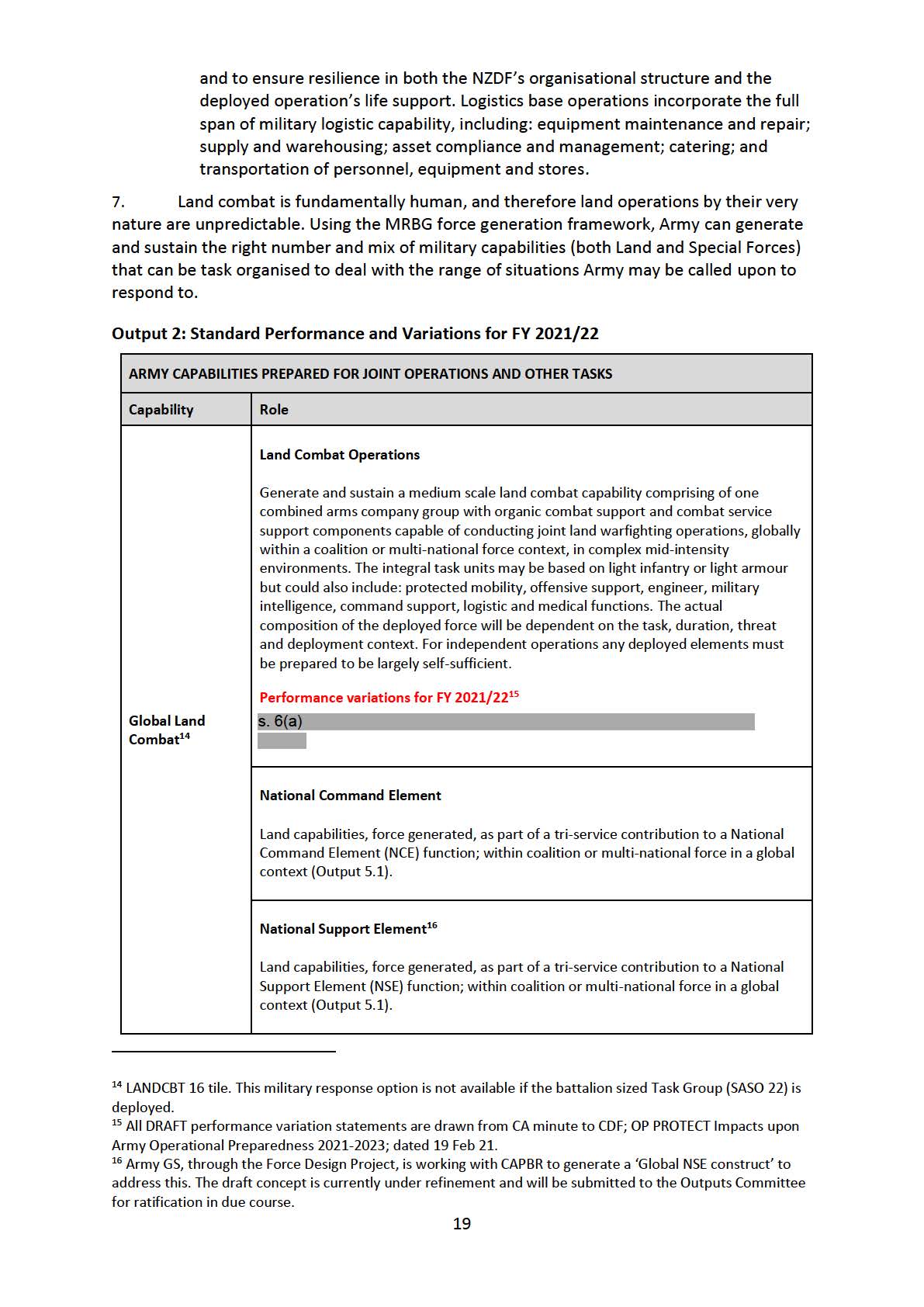
RELEASED UNDER THE OFFICIAL INFORMATION ACT 1982
Regional Stability and Support Operations Task Group
Generate and sustain ‘light’ forces able to be deployed by air and sea; prepared to
conduct stability operations.18 At the largest scale the commitment will consist of an
all-arms battalion sized Task Group. When combined with HQ DJIATF, able to lead and
conduct independent regional Stability and Support Operations (SASO) or as part of a
coalition or multi-national operation in a mid intensity SASO environment. The Task
Group is complete with infantry, protected mobility, offensive support, engineer,
military intelligence, command support, logistic and medical functions. If the battalion
sized Task Group is not deployed land forces are able to provide:
high-readiness contingency forces (High Readiness Task Unit - HRTU and HADR Task
Unit);
concurrent bespoke medium sized task groups (including global options under
LANDCBT 16) or smaller task units and/or task elements.
These military response options are structured and equipped to provide credible
combined arms contributions to all types of SASO and can command additional
attached sub-units, including force elements from contributing partner nations.
Performance variations for FY 2021/22
s. 6(a)
Regional Stability and Support
Regional High Readiness Task Unit (HRTU)19
Operations17
Designated high readiness, contingency, Land capabilities, based on an Infantry
Company. The HRTU is able to be deployed by air in order to quickly respond to
security related regional crises and assist with the restoration of law and order. The
HRTU can be employed independently, as part of a coalition, within an amphibious
Joint Task Force, as a task unit within a NZ Task Group or in support of the
SOTG/Special Operations Forces.
Performance variations for FY 2021/22
s. 6(a)
Regional Humanitarian Assistance and Disaster Relief (HADR) force20
Designated high readiness, contingency Land capability force of Task Unit size; based
predominantly (but not exclusively) on military Engineer, Medical and Logistic
components. The HADR force is prepared to conduct Regional Humanitarian Aid and
Disaster Relief activities to meet the immediate needs of impacted States and relieve
the suffering of devastated peoples; either independently or as part of a multi-
national response.
Performance variations for FY 2021/22
Able to meet, with risk, specified high readiness Regional Stabilisation (Humanitarian
Assistance and Disaster Relief Task Unit) military response.
17 SASO 22 tile with SASO 20 (DJIATF) tile.
18 Note that the term ‘light’ reflects a force’s agility, deployability, sustainability and its light scales of
equipment; it does not imply that it is based on ‘light’ infantry. In general the force will be self-supporting (less
theatre-level logistic support), possess high levels of tactical protected mobility (terrain appropriate) but with
moderate levels of protection and firepower. The actual nature of the task to be completed and the
environment within which it is to be undertaken will ultimately dictate the force composition of the Army’s
military response option.
19 If the battalion sized Regional Stability and Support Operations Task Group is not deployed.
20 If the battalion sized Regional Stability and Support Operations Task Group is not deployed.
20
RELEASED UNDER THE OFFICIAL INFORMATION ACT 1982
Concurrent Medium and Small Scale Military Response Options21
Land capabilities consisting of medium scale Task Groups (including global options
under LANDCBT 16) or smaller Task Unit sized forces. The integral task units may be
based on light infantry, offensive support, engineer, intelligence, command support,
logistics and medical functions. Response options will be constituted from already
formed teams with integral command and support elements and will be able to
conduct independent regional Stability and Support Operations (SASO) or as part of a
coalition or multi-national operation, complete with protected mobility in a mid-
intensity environment.
Performance variations for FY 2021/22
s. 6(a)
Deployed Joint Inter Agency Task Force Headquarters/National Command Element
Land capabilities, force generated, as part of a tri-service contribution to a deployable
national command capability able to command joint, interagency, multinational and
coalition military operations within a regional context (Tile SASO 20, Output 5.2).
National Support Element22
Land capabilities, force generated as part of a tri-service contribution to a National
Support Element (NSE) function either within a lead nation or as part of a coalition or
multi-national force within a regional context (Output 5.2).
Standing Commitments
Specialist Land capabilities prepared to provide immediate response personnel and
equipment to augment Fire and Emergency New Zealand capacity with assistance in
rural fire-fighting operations and provision of first-responder capabilities and
Domestic
attendance at road traffic incidents in the Central Plateau (Output 4.3).
operations (in
addition to
Provision of military capability to deliver effective military intelligence services, advice
LANDCBT 16 and
and support to the Government (Output 6).
SASO 22)
Contingency Forces
Provision of contingency military forces (both Regular and Reserve) prepared to assist
the Civil Power when dealing with major disasters, the maintenance of law, order and
public safety, and support to the community (Output 4.3).
Special Operations Task Group
s. 6(a)
21 If the battalion sized Regional Stability and Support Operations Task Group is not deployed.
22 AGS, through the Force Design Project, is working with CAPBR to generate a ‘Regional NSE construct’.
21
RELEASED UNDER THE OFFICIAL INFORMATION ACT 1982
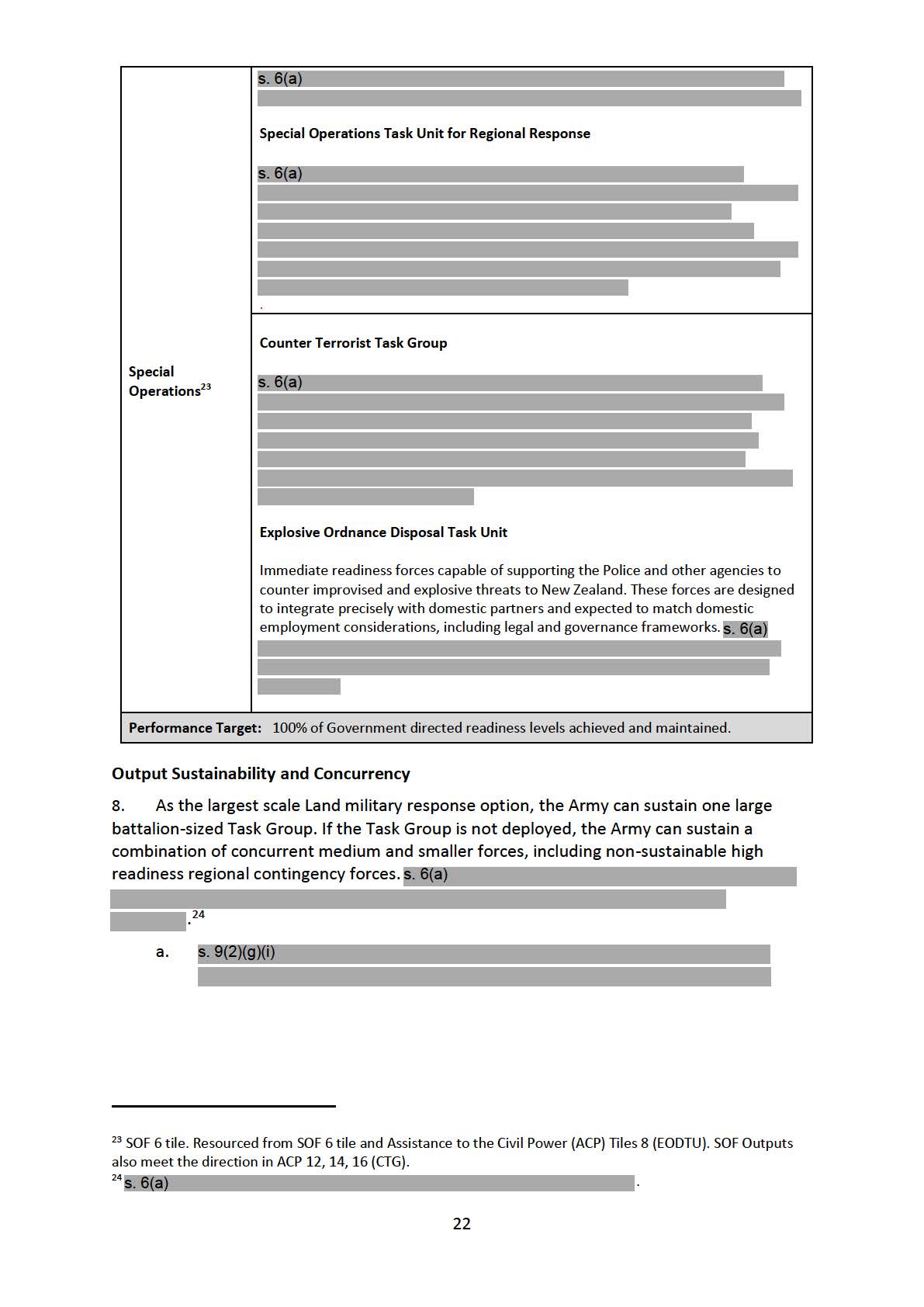



RELEASED UNDER THE OFFICIAL INFORMATION ACT 1982
s. 9(2)(g)(i)
b.
Army can sustain a combination of concurrent medium and smaller forces
(including high readiness regional contingency forces) only if the battalion-sized
Task Group is not deployed.27 Concurrent deployments that require force
elements to be drawn from the second rotation would mean these deployments
would be declared as ‘non-enduring’. This would mean that ‘output
sustainment’ can only be re-declared after appropriate force regeneration.
c.
The Reserve component is integral to Army’s ability to be able to field military
capability to sustain Army’s outputs. The initial deployed Land force contains key
specialist skillsets only held in the Reserves. Subsequent rotations rely on an
increasing Reservist contribution until a steady state is achieved. The Reserve
contribution will consist of both individual augmentation (both specialist and
generalist) as well as formed Force Elements. The actual numbers and nature of
the contributions will be tailored accordingly to the mission, context and
duration.
s. 6(a)
25 s. 6(a)
26 Military sustainability is based on the ‘rule of 3’ – to sustain one force in the field you actually need three to
create a ‘Force Generation’ cycle. These consist of the ‘Deployed’ force (those actually on operations), the
‘Generating’ Force (those preparing to take over from those on operations) and the ‘Regenerating’ force
(those recuperating post operational deployment).
27 Clearly articulated in DMRR13, DWP16 and DCP19.
28 It is notable that the Army provides the only specialist military capabilities made permanently available to
assist the civil power; the Counter-Terrorist Task Group and Explosive Ordnance Disposal Task Unit. In addition,
regular Special Operations Forces training with Joint Forces assets, provides Police and other agencies with
national response options of significant scale and lethality and maintains the projection timeframes expected
for regional response.
23
RELEASED UNDER THE OFFICIAL INFORMATION ACT 1982
Output 3: Air Force Capabilities
This category of output expense is limited to the generation of Air Force capabilities that
achieve the levels of readiness for military operations and other tasks directed by the
Government of New Zealand.
1.
The Air Force’s unique capabilities contribute to the overall capacity of the Defence
Force to defend New Zealand, contribute to regional security, enforce compliance with
international law and protect national interests offshore.
2.
The Air Force generates and prepares combat-capable, multi-role air capabilities
that can provide air power, with specialised mission and expeditionary support capabilities.
The Air Force retains the capability to contribute to and be integrated within a coalition
Combined Air Operations Centre.
3.
The Air Force manages the generation and sustainment of air capabilities and
utilises these same capabilities for non-combat tasks to assist the civil power and support
other government agencies. This is accomplished by bringing air capabilities to the readiness
states for operations by organising personnel, equipment, materiel and supplies, as well as
the provision of individual, unit, collective and joint training, that prepares and delivers air
capabilities to the performance specifications detailed in the annex to the NZDF Output
Plan, specifically:
a.
a surveillance and response capability prepared for counter sea operations in
support of maritime warfare operations;
b.
a surveillance and response capability prepared for intelligence, surveillance and
reconnaissance operations in support of maritime security operations;
c.
a naval air combat capability for embarkation in surface ships for maritime
warfare and security operations;
d.
a surveillance and response capability prepared to support special operations
forces and other specified forces in the land and maritime environments;
e.
a strategic air mobility capability prepared to deploy, sustain and recover
deployed forces;
f.
a theatre air mobility capability prepared for personnel movement and cargo
operations within a designated theatre of operations; and
g.
a tactical air mobility capability prepared to support land operations, special
operations forces, aeromedical evacuation and joint personnel recovery.
4.
s. 6(a)
24
RELEASED UNDER THE OFFICIAL INFORMATION ACT 1982

RELEASED UNDER THE OFFICIAL INFORMATION ACT 1982
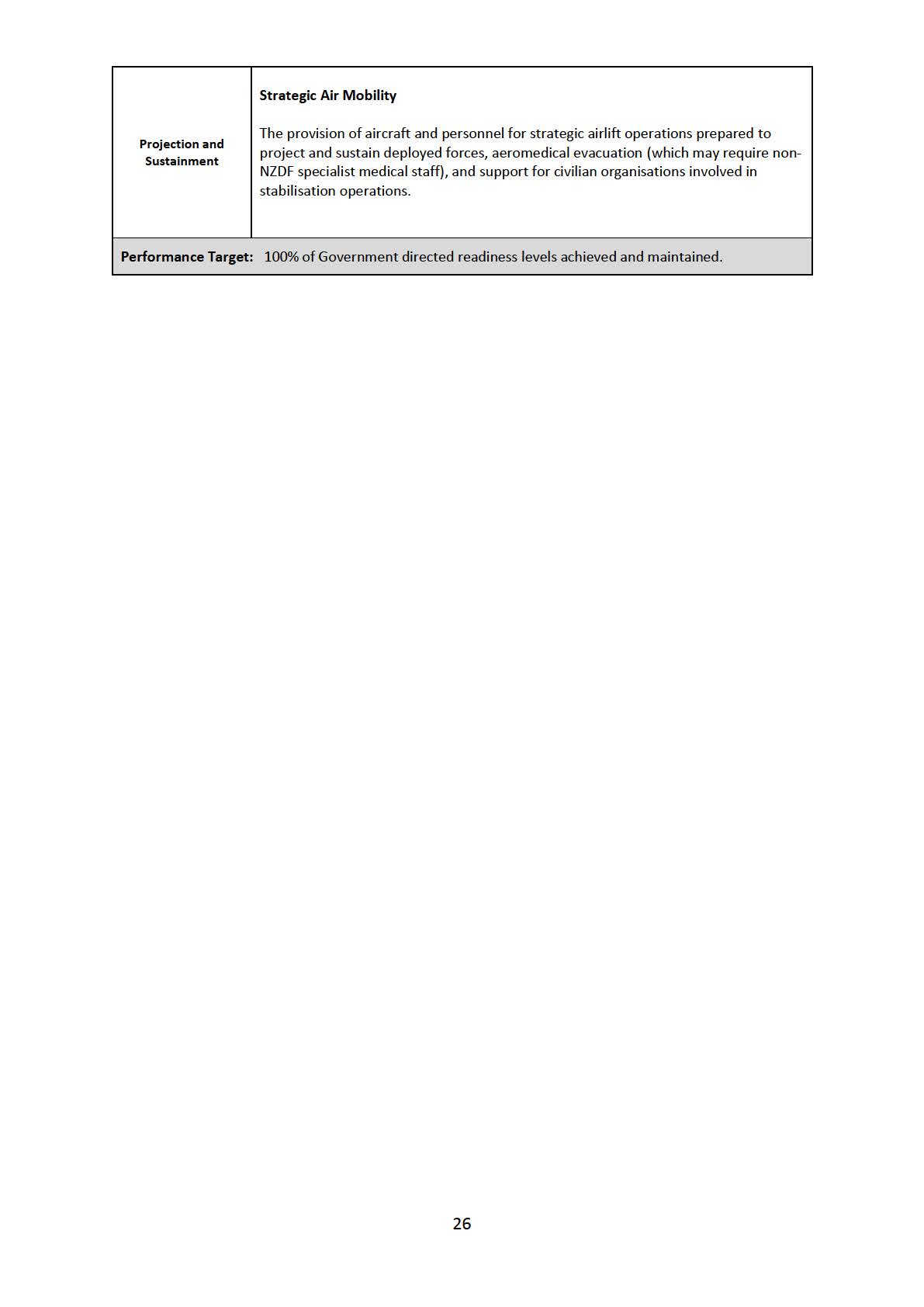
RELEASED UNDER THE OFFICIAL INFORMATION ACT 1982
OUTPUT 4: PROTECT
Protection of New Zealand and New Zealanders
The single overarching purpose of this appropriation is to protect New Zealand’s sovereignty
and provide security and other services for New Zealanders.
1.
Protecting New Zealand’s sovereignty and the provision of security for New
Zealanders, whether at home or abroad, is not the business of any one government agency,
nor any one Service of the NZDF.
2.
There are a range of contingencies where the Government may commit New
Zealand’s Armed Forces, including border and resource protection, assistance to civil
authorities29 in emergency and non-emergency situations as well as providing support to
the New Zealand community. Furthermore, a programme of defence international
engagement contributes to international rules-based order and the security of New
Zealanders.
3.
This Output Class utilises the generation of military combat capability delivered to
the Government through our principal outputs (Outputs 1 – 3). It involves the integration
and preparation of Force Elements (joint and common enabling capabilities, and deployable
command capabilities) and formation of Joint Task Forces, Task Groups and specialised
forces for employment to protect New Zealand’s sovereignty and provide security for New
Zealanders. It provides a rapid response capability to a security event or crisis within New
Zealand, where there is a need to conduct humanitarian assistance and disaster relief or
support to New Zealand authorities in the conduct of security duties. Through Defence
Attachés, it plays a fundamental role in defence diplomacy.
4.
This Multi Category Appropriation comprises five discrete outputs:
a.
Resource and Border Protection Operations. The sharing of information and
provision of resources to support all-of-government efforts to protect New
Zealand’s borders and offshore maritime interests.
b.
Defence International Engagement. The provision of services and utility of the
Defence Force to support foreign policy objectives that strengthen security and
avert conflict.
c.
Assistance to the Civil Power and Provision of a Public Service in Emergency
Situations. The provision of specialist military capabilities and Defence Force
resources provided to the civil power in an emergency and for urgent work of
national importance.
d.
Military Assistance to Civil Authorities in Non-Emergency Situations. The
provision of NZDF resources, services and non-emergency assistance periodically
provided to the Government and civil authorities.
e.
Defence Support to the Community: The provision of NZDF resources for the
betterment of the community at large and to inform the public’s awareness of
the proficiency and practice of the Armed Forces.
29 For avoidance of doubt; Civil Power means the New Zealand Police and Civil Authorities means any
governmental department or agency that has the authority to call on Defence Force capabilities (normally
arranged through the provisions of a Memorandum of Understanding).
27
RELEASED UNDER THE OFFICIAL INFORMATION ACT 1982
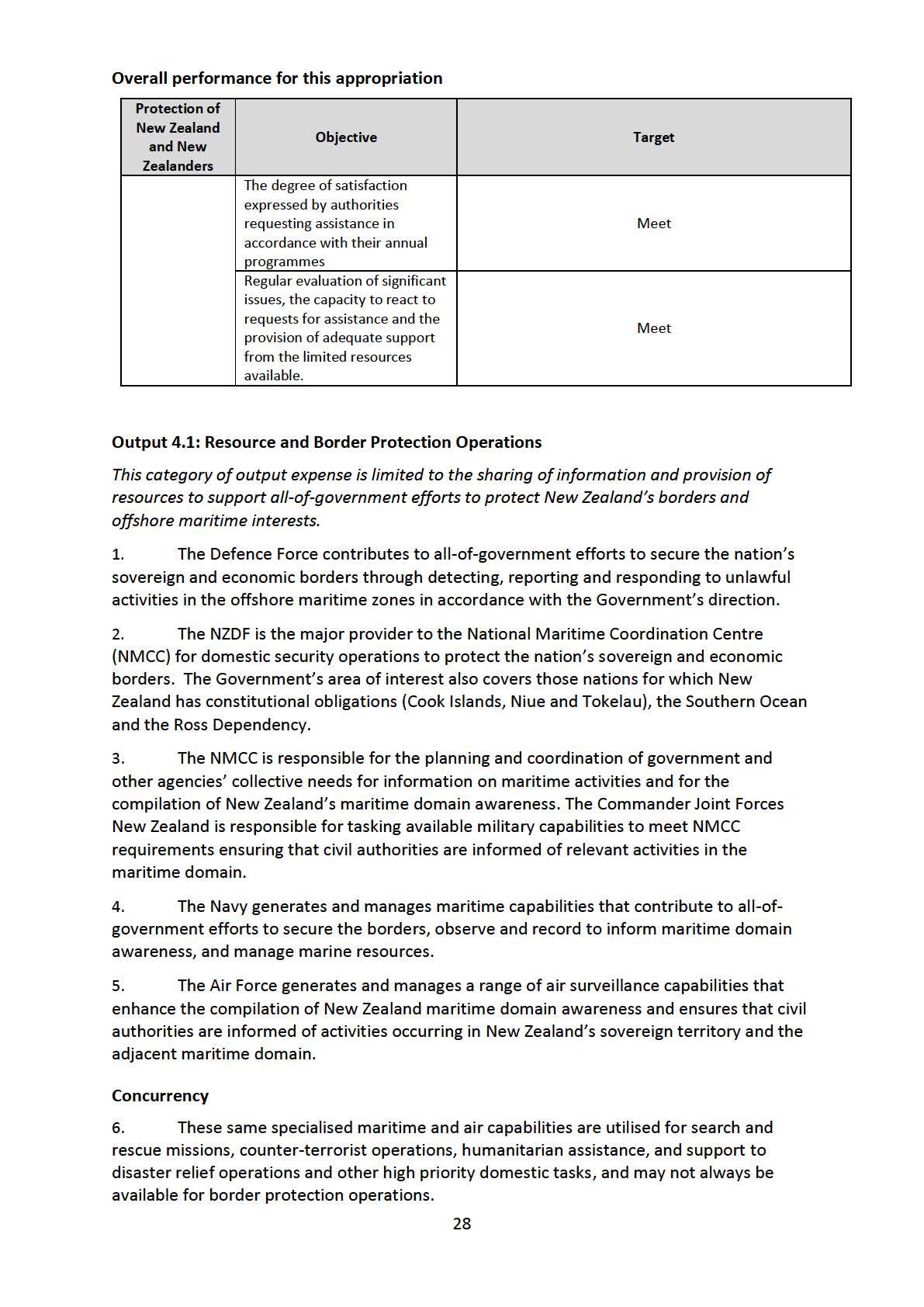
RELEASED UNDER THE OFFICIAL INFORMATION ACT 1982
Output 4.1: Deliverables
7.
The Defence Force manages the generation of air and maritime capabilities that
enable civil authorities to understand the maritime environment and to detect, locate,
track, interdict and inspect vessels of interest in those areas under New Zealand’s oversight.
Specifically:
a.
The provision and exchange of information on maritime traffic, suitably
adapted to civil needs, to the NMCC.
b.
The provision of air and maritime capabilities for the conduct of routine
surveillance and interdiction tasks in the high-risk areas of the territorial
waters, Exclusive Economic Zone, Southern Ocean and the Ross Dependency,
including those areas managed under the auspices of the CCAMLR.
c.
The provision of assistance to Antarctica NZ operations in New Zealand and
at Scott Base and the Ross Dependency and contributions to the Joint US/NZ
Logistics Pool.
d.
The availability of air and maritime capabilities to respond to actual or
potential non-compliance with New Zealand legislation under the direction of
civil authorities.
e.
The provision of routine assistance to government agencies for servicing New
Zealand’s offshore islands.
29
RELEASED UNDER THE OFFICIAL INFORMATION ACT 1982
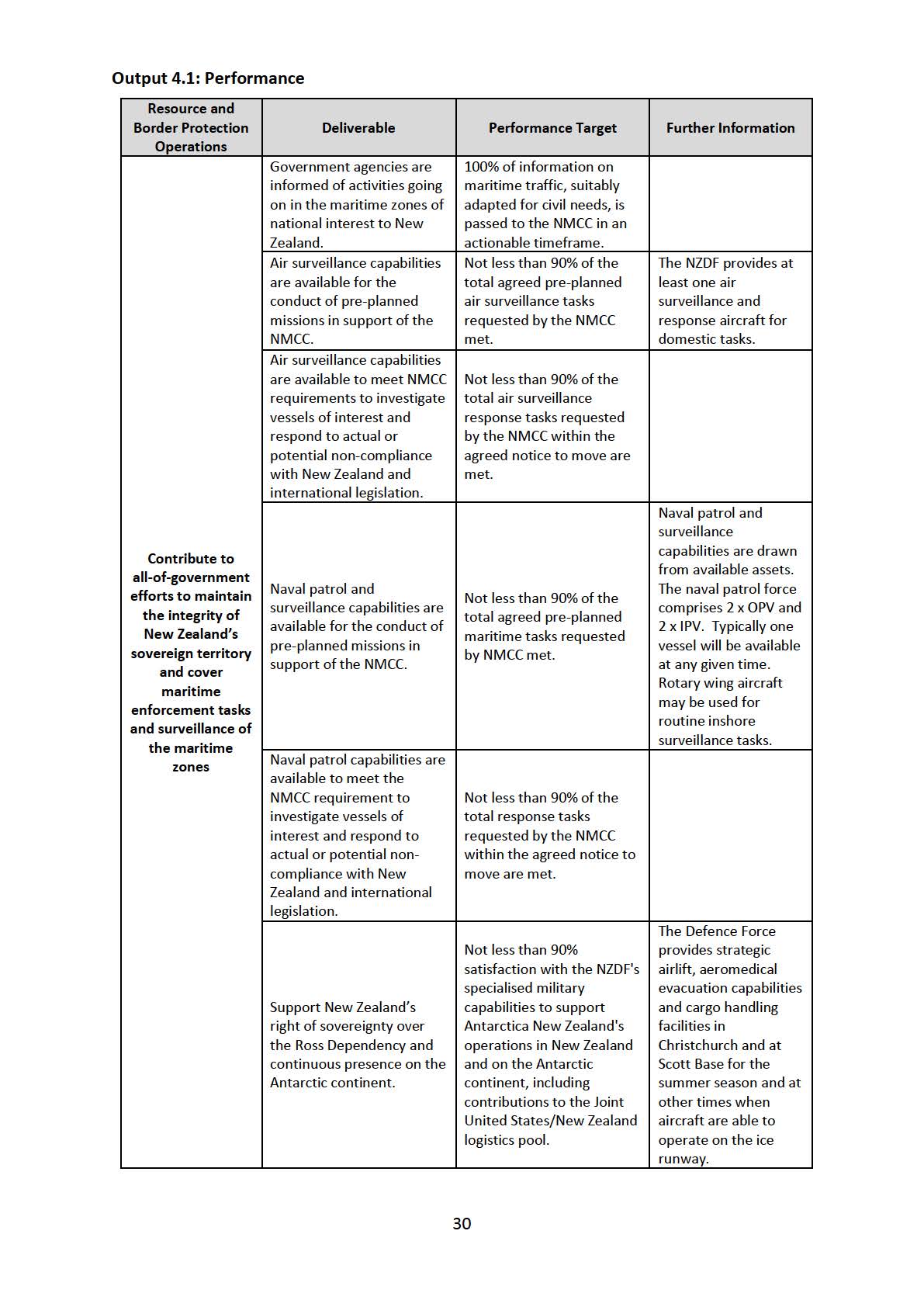
RELEASED UNDER THE OFFICIAL INFORMATION ACT 1982
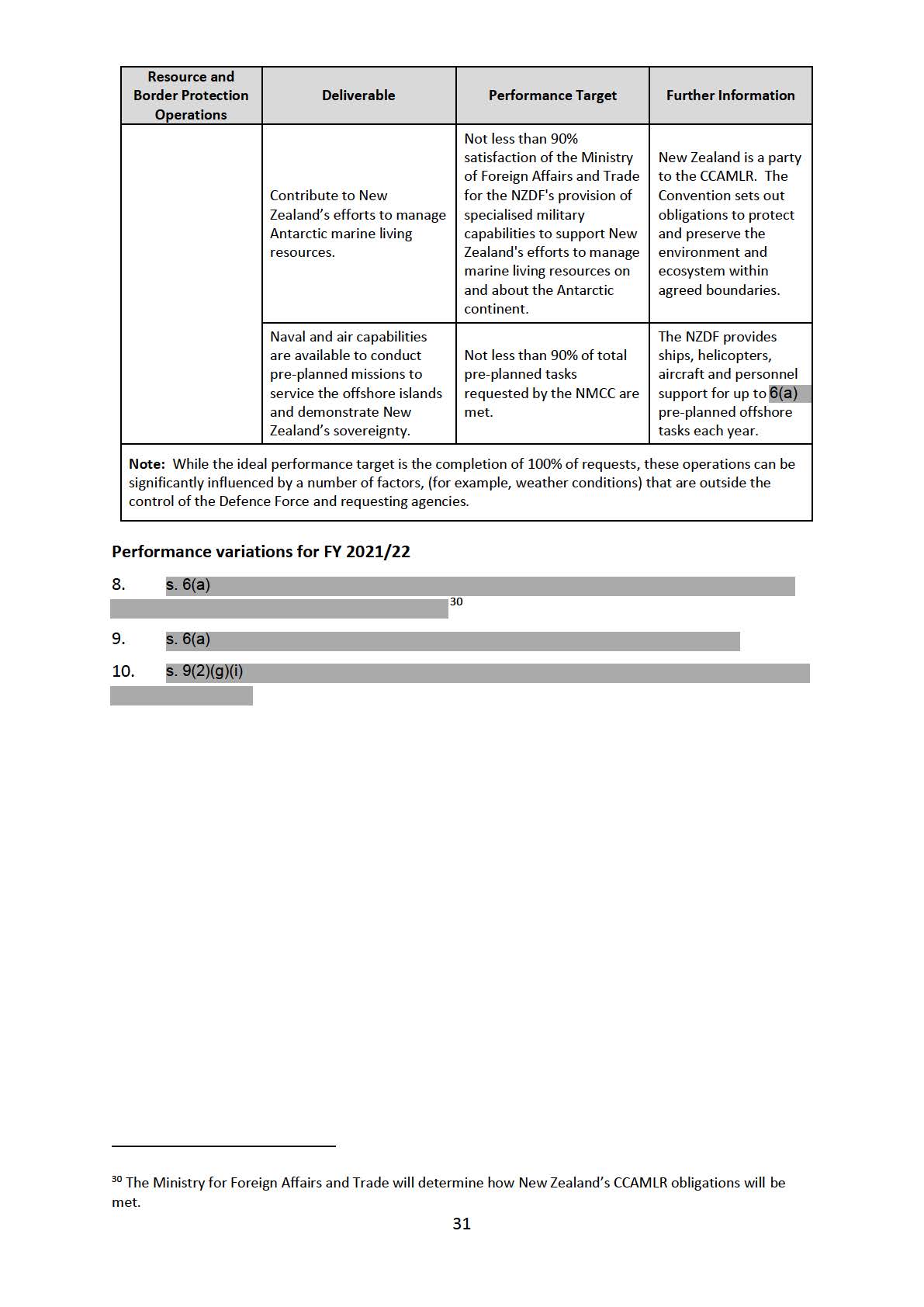

RELEASED UNDER THE OFFICIAL INFORMATION ACT 1982
Output 4.2: Defence International Engagement
This category of output expense is limited to the provision of services and utility of the
Defence Force to support foreign policy objectives that strengthen security and avert conflict.
1.
Defence International Engagement supports the Government’s foreign policy
priorities and contributes to international peace and security.
2.
Defence relationships assist in building confidence between nations. They are
important to ensuring we can work in an international environment with trusted partners in
crises. They can also provide access to equipment, information and intelligence and training
opportunities.
3.
Defence Attachés31, in particular, play a fundamental role in defence diplomacy.
Their interaction is instrumental in building alliances, coalitions, and partnerships to ensure
co-operation, burden-sharing and interoperability and provides critical situational
awareness, information and influence within multinational organisations.
4.
Closer to home, regional engagement is normally characterised by joint inter-
agency missions, conducted on a bilateral or multinational basis to provide foreign aid and
assist with capacity building in selected nations. These activities are intended to shape the
security environment and are aimed at encouraging local or regional stability and resilience.
They offer opportunities for nations to create a secure environment for economic growth
and the social wellbeing of the population.
5.
Defence Force contributions typically involve regular operations with other
government departments and international organisations, assisting regional nations to
manage their marine resources and to support the provision and distribution of aid to
Pacific Island nations (e.g. NZ Aid Programme, assistance provided during operational
exercises, and specific international assistance programmes like
Pacific Partnership).
Output 4.2: Deliverables
6.
Through the generation of military capabilities for operational roles and specific
national representation abroad, the Defence Force contributes to Government’s foreign
policy objectives and maintains a comprehensive network of valuable defence-related
relationships. The defence diplomacy element of this output specifically captures the
following:
a.
Military-to-military engagement;
b.
Participation in formal arrangements and alliances;
c.
Senior officer visits;
d.
Maritime deployments and ship visits;
e.
Regional engagement and capacity building activities (including support for the
management of marine resources and military exercises that are mandated to
provide civil and military co-ordination to a host nation);
f.
Military exercises that help develop confidence and security-building measures;
31 Includes other Defence Force advisers appointed to specific posts (for example, United Nations Military
Advisor, Maritime Security Advisers).
32
RELEASED UNDER THE OFFICIAL INFORMATION ACT 1982

RELEASED UNDER THE OFFICIAL INFORMATION ACT 1982
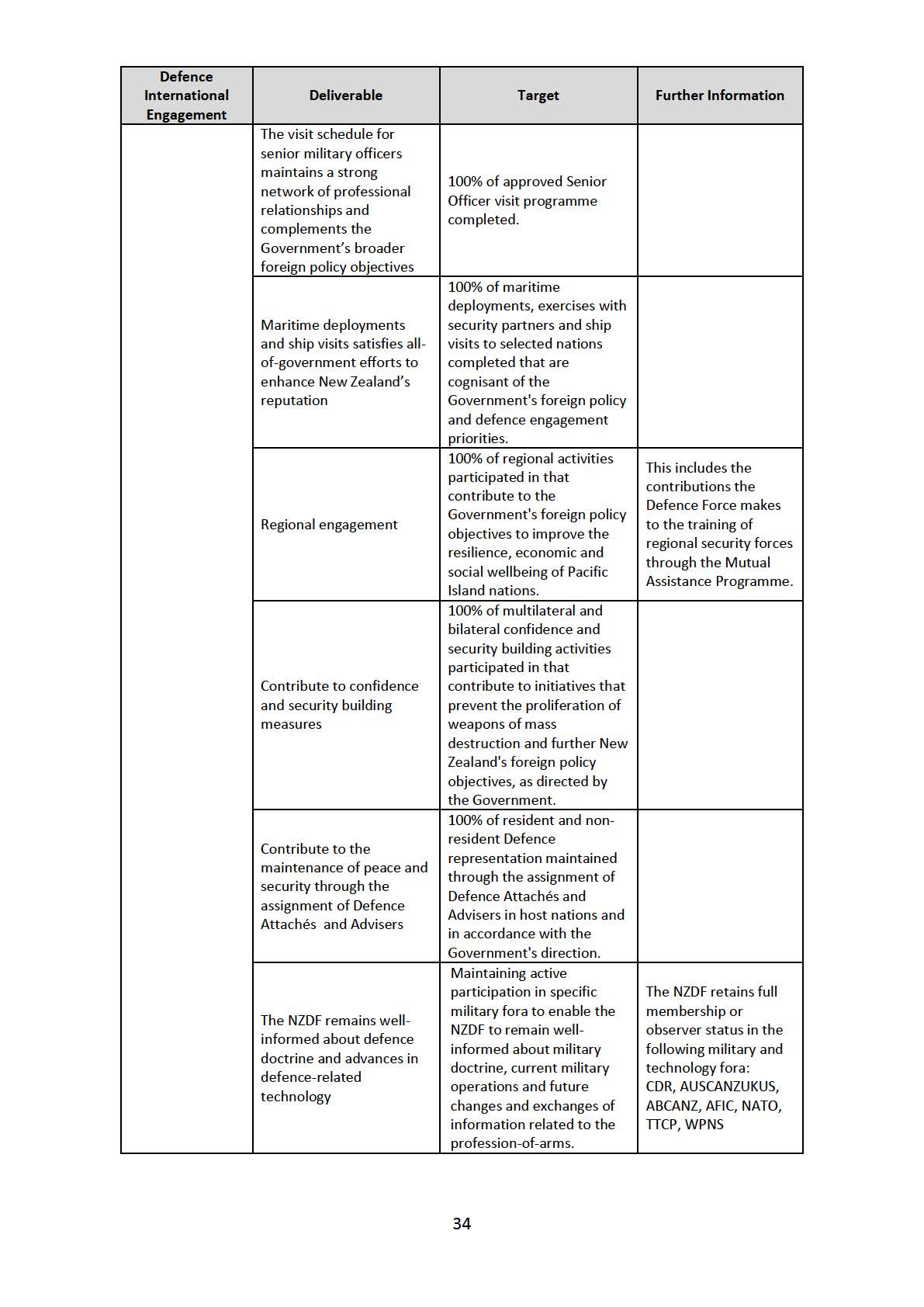
RELEASED UNDER THE OFFICIAL INFORMATION ACT 1982

RELEASED UNDER THE OFFICIAL INFORMATION ACT 1982
Output 4.3: Assistance to the Civil Power and Provision of a Public Service in Emergency
Situations
This category of output expense is limited to the costs of specialist military capabilities and
Defence Force resources provided to the civil power in an emergency and for urgent work of
national importance.
1.
This particular output involves responding to requests from the civil power to save
lives, prevent human suffering and mitigate exceptional property damage (e.g. following a
major disaster), Search and Rescue and recovery operations and responses to maritime
incidents.
2.
The output also covers the NZDF high-readiness capabilities available to assist the
civil power when asymmetric threats (acts of terrorism, bomb threats) and other incidents
could affect critical national services or impact upon the safety of the population.
3.
The output focuses on the provision of military assistance to the civil power using
specialised military capabilities or equipment in situations that are beyond the capacity of
the civil power to deal with and where the Defence Force is able to provide unique
capabilities not held elsewhere. Specifically, the Defence Force contributes to all-of-
government efforts, in times of emergency, to maintain supplies and services essential to
the life and the health and safety of the community; to save lives and mitigate the impacts
of a natural disaster or major emergency, and to maintain public safety.
4.
While constituted and maintained as New Zealand’s military instrument of national
power, Defence Force capabilities (particularly the ability to deploy significant numbers of
personnel quickly and across large distances) can provide valuable support in the event of
public security and public welfare emergencies and can assist other government
departments and agencies in times of crises.
5.
Under section 9 of the
Defence Act 1990, the Armed Forces may be used to
perform any public service and assist the civil power in time of emergency.
6.
Under the provision of a public service, the NZDF is expected to assist government
departments to sustain services in an emergency or when a situation exceeds the
capabilities of the civil power, including during periods of industrial unrest.
7.
The NZDF’s contribution to domestic tasks is provided through military capabilities
and procedures unless exceptional circumstances require otherwise. In domestic tasks, the
NZDF responds to requests from lead civil agencies; with the exception of routine
sovereignty operations and its defence-of-New Zealand role, the Defence Force is always in
support. For matters of public safety, assistance will routinely be to the NZ Police, as the
lead organisation, which also includes Defence Force support for police-led security and law
enforcement operations. Working together with the civil power and civil authorities ranges
from formally agreed and documented arrangements to informal coordination on matters
of common interest.
8.
In contributing a military response, the NZDF makes available Regular and Reserve
Forces at varying degrees of notice to move. Unlike specialised units, these forces do not
train for these types of tasks but are able to provide the required capabilities by virtue of
training for warfighting. A contribution may or may not be associated with a declared
disaster or civil emergency and, except where formal arrangements exist, authorisation at
the appropriate level is required before the NZDF provides assistance in many
circumstances.
36
RELEASED UNDER THE OFFICIAL INFORMATION ACT 1982
Output 4.3: Deliverables
9.
These standing commitments and specific assistance for various security events
reported under this output include:
a.
the conduct of counter-terrorist operations in the land and maritime domains;
b.
the disposal of explosive ordnance32, improvised explosive devices33 and
response to chemical, biological and radiological threats in the land and
maritime environments;
c.
search and rescue and recovery;
d.
assistance to the civil power for law enforcement operations;
e.
assistance to Fire and Emergency New Zealand;
f.
cordon duties, i.e. controlling access to an incident scene;
g.
assistance to the National Emergency Management Agency;
h.
aeromedical evacuation and medical rescue at sea;
i.
mitigation of the effects of adverse weather conditions;
j.
response to maritime incidents and marine pollution;
k.
the mass evacuation of persons from high-risk environments;
l.
response to major bio-security incidents;
m.
response to pandemic crises;
n.
assistance to the Department of Corrections;
o.
all-of-government contingency planning activities;
p.
multi-agency training activities;
q.
assistance to Customs and NZ Police for the generation of their specialist diving
teams;
r.
provision of Defence Force airfield facilities as an alternate for large civilian
aircraft during short notice closure of scheduled destinations due to weather or
other emergencies; and
s.
support to all-of-government intelligence activities.
32 The location, identification, rendering safe and final disposal of ammunition, pyrotechnics and explosive
stores which may have not functioned, or which may have not been fired.
33 The location, identification, rendering safe and final disposal of improvised explosive devices; devices
fabricated in an improvised manner designed to destroy, disfigure, distract or harass.
37
RELEASED UNDER THE OFFICIAL INFORMATION ACT 1982
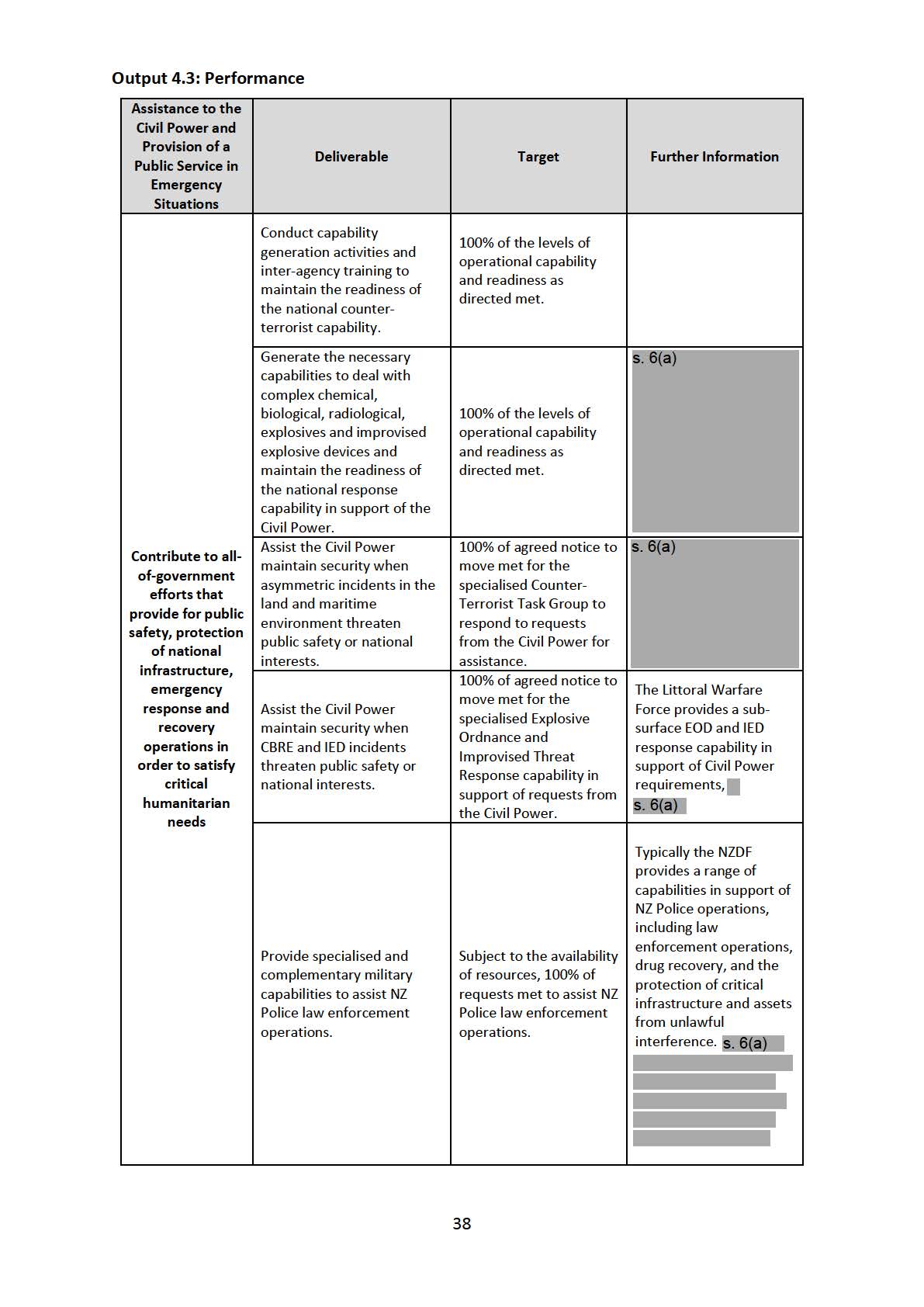



RELEASED UNDER THE OFFICIAL INFORMATION ACT 1982
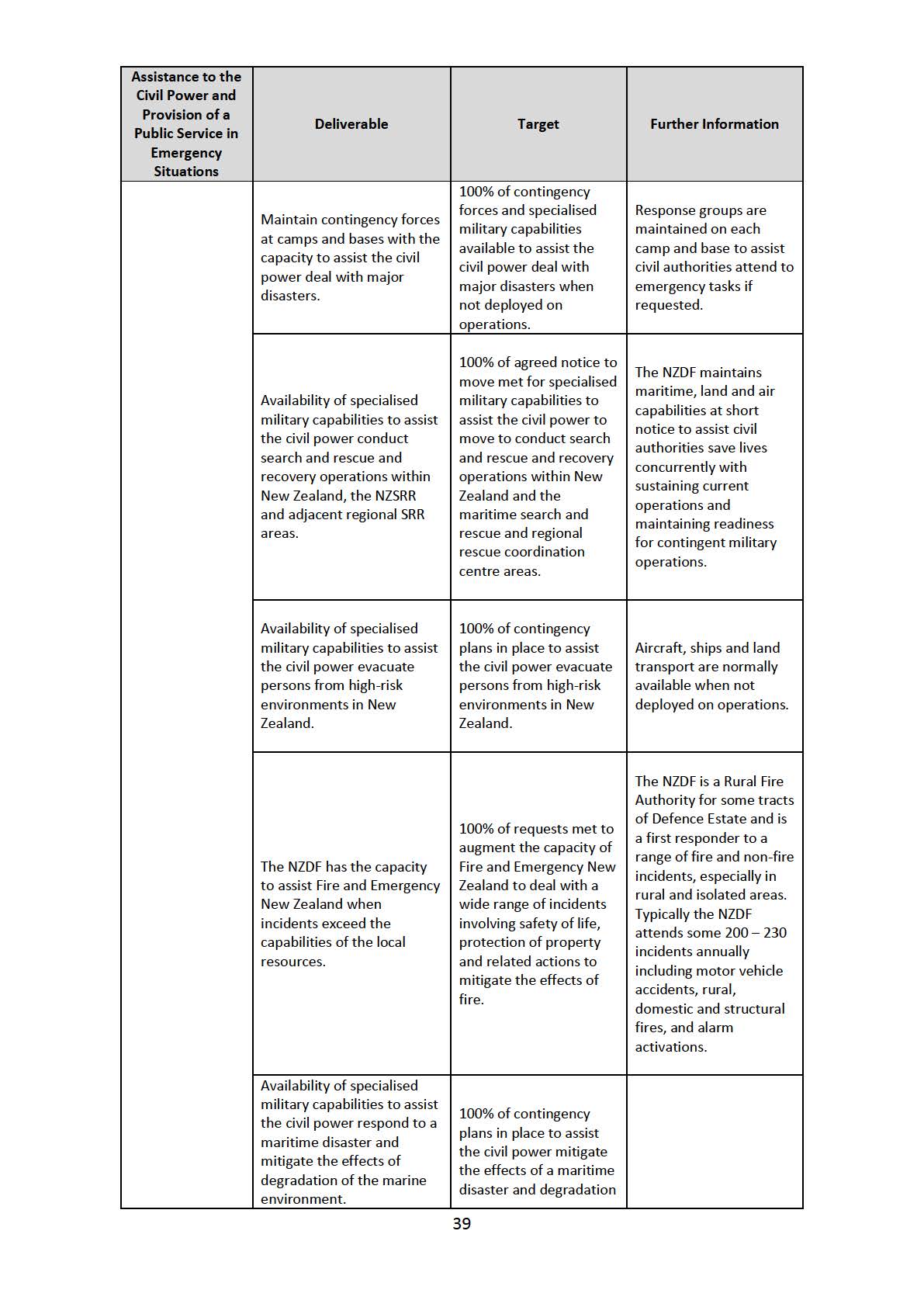
RELEASED UNDER THE OFFICIAL INFORMATION ACT 1982
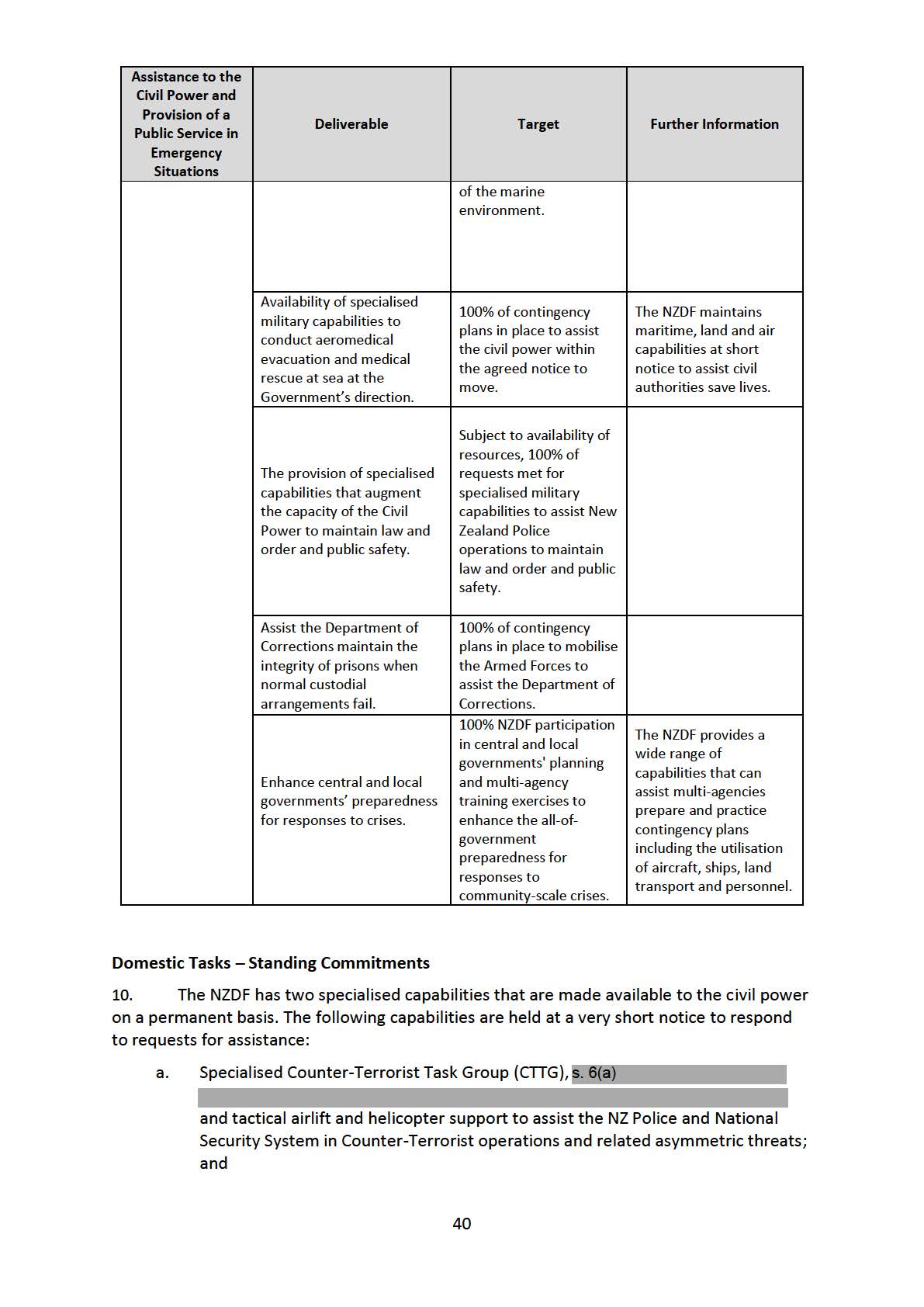


RELEASED UNDER THE OFFICIAL INFORMATION ACT 1982
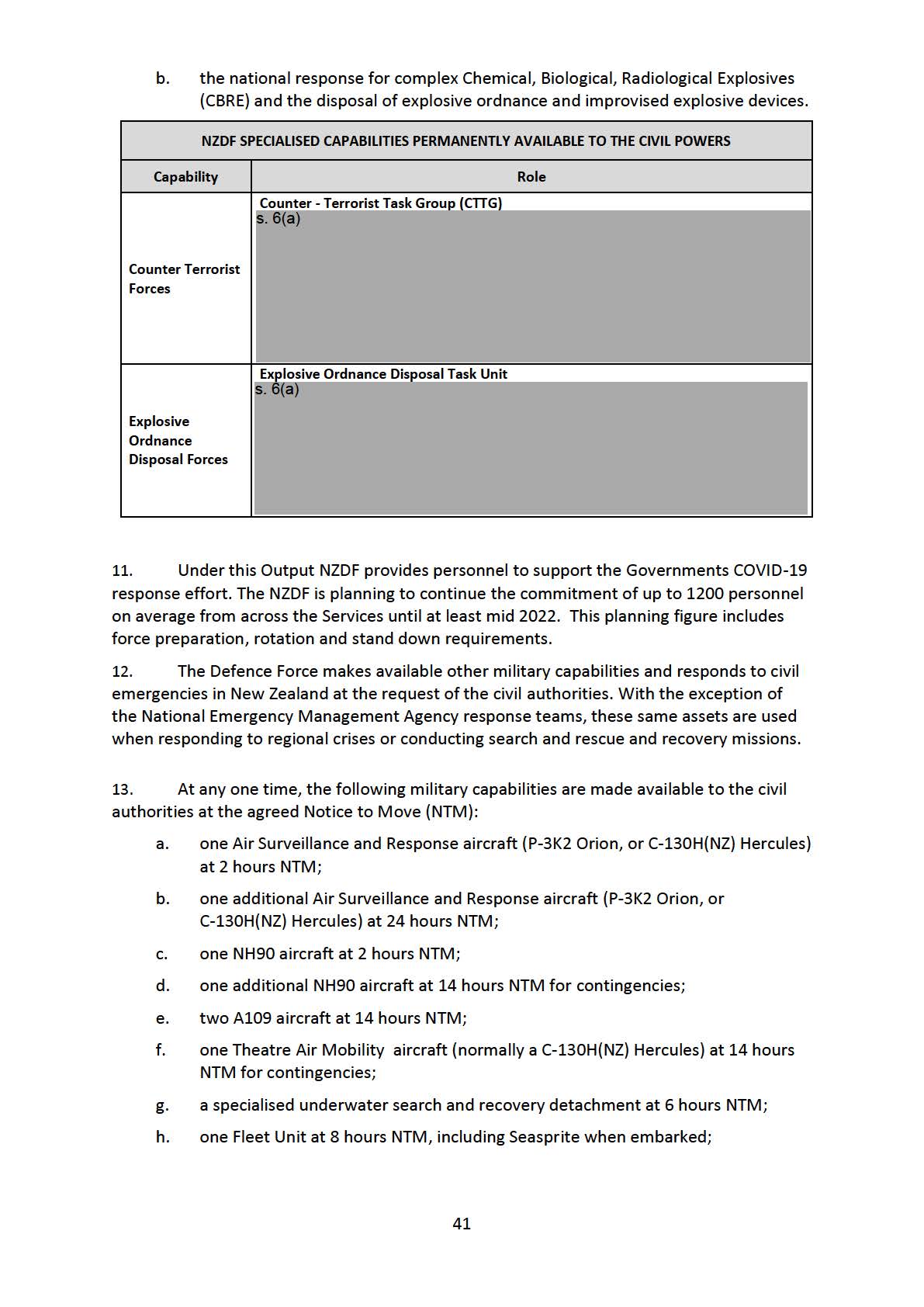
RELEASED UNDER THE OFFICIAL INFORMATION ACT 1982
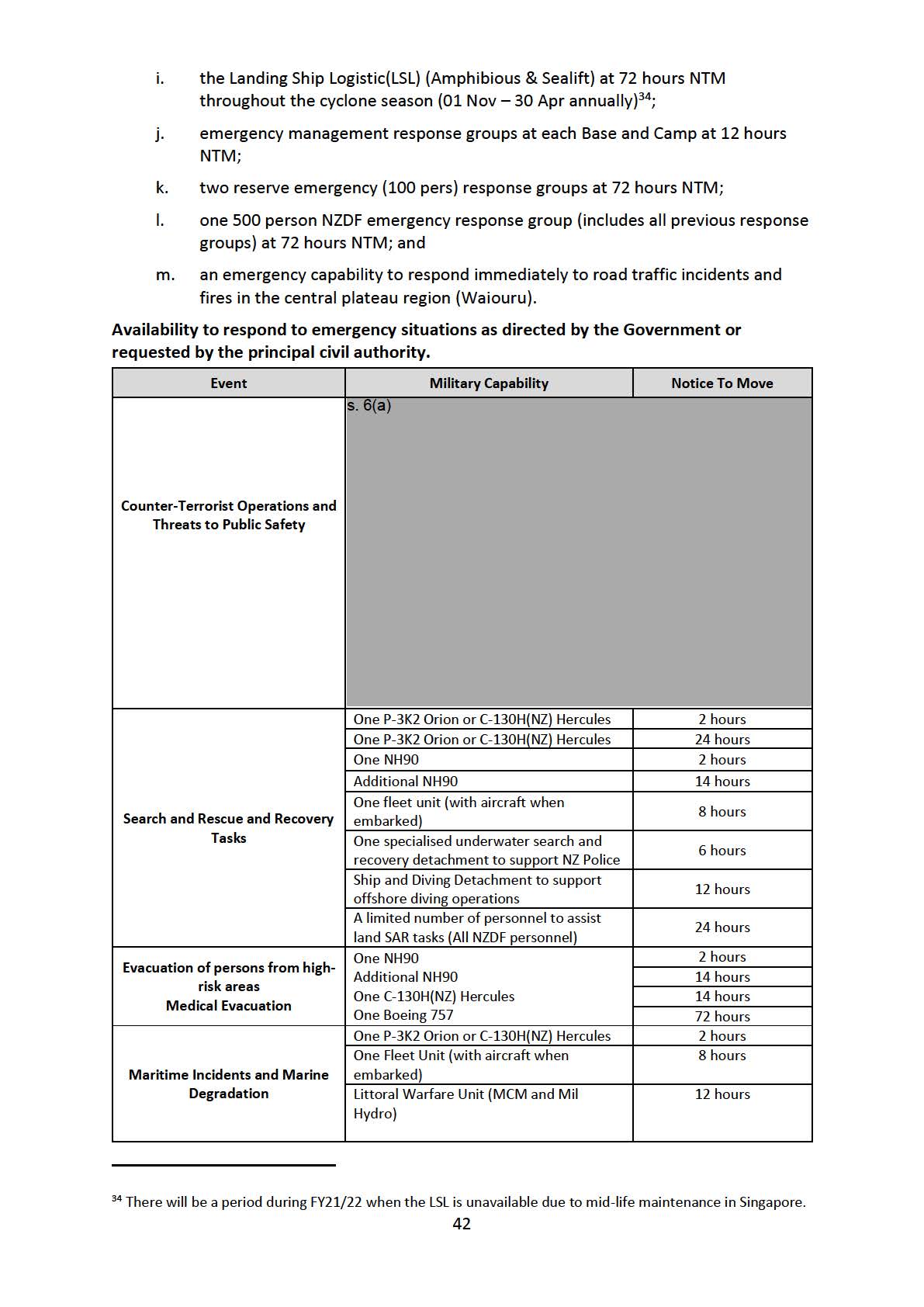
RELEASED UNDER THE OFFICIAL INFORMATION ACT 1982
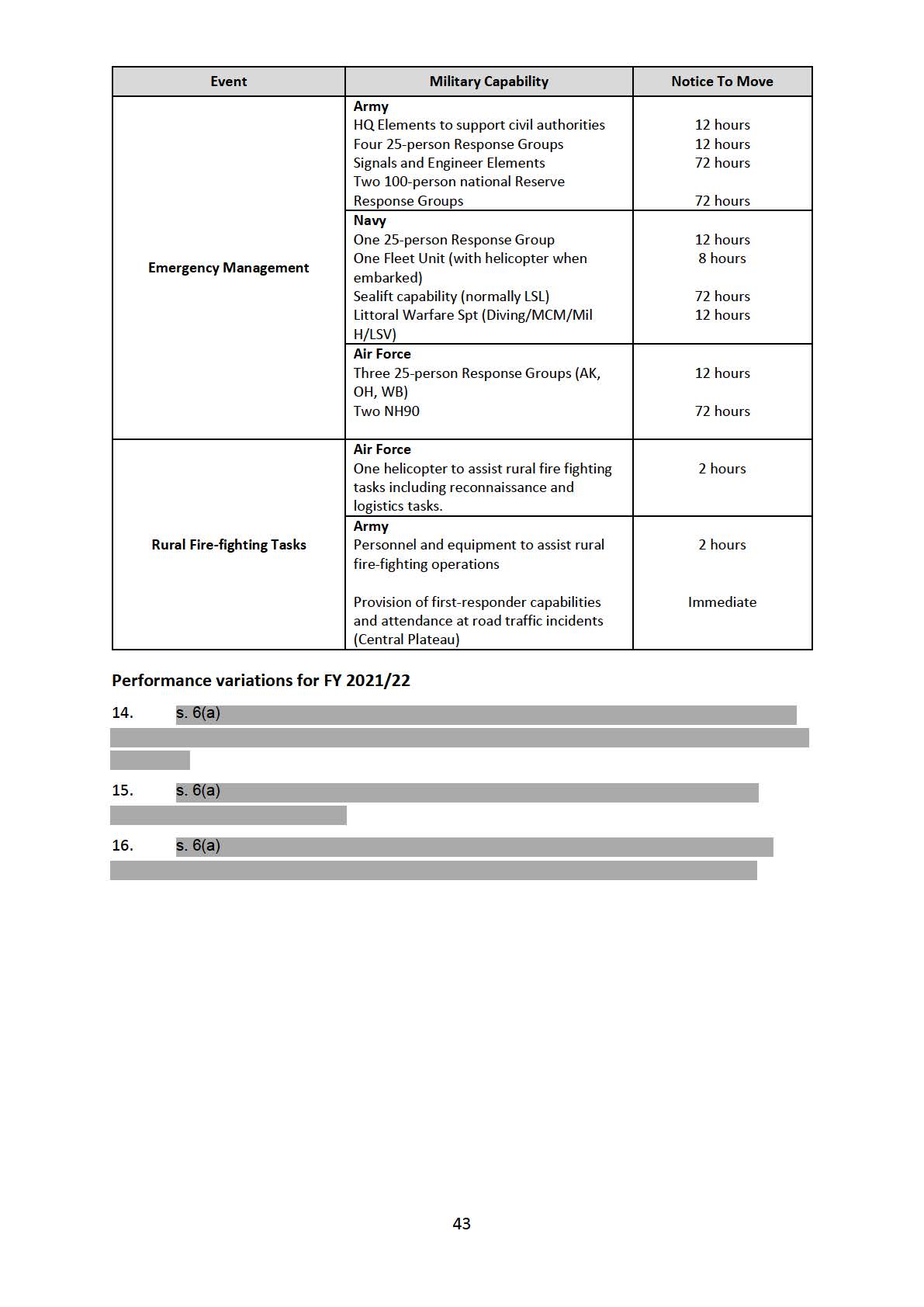


RELEASED UNDER THE OFFICIAL INFORMATION ACT 1982
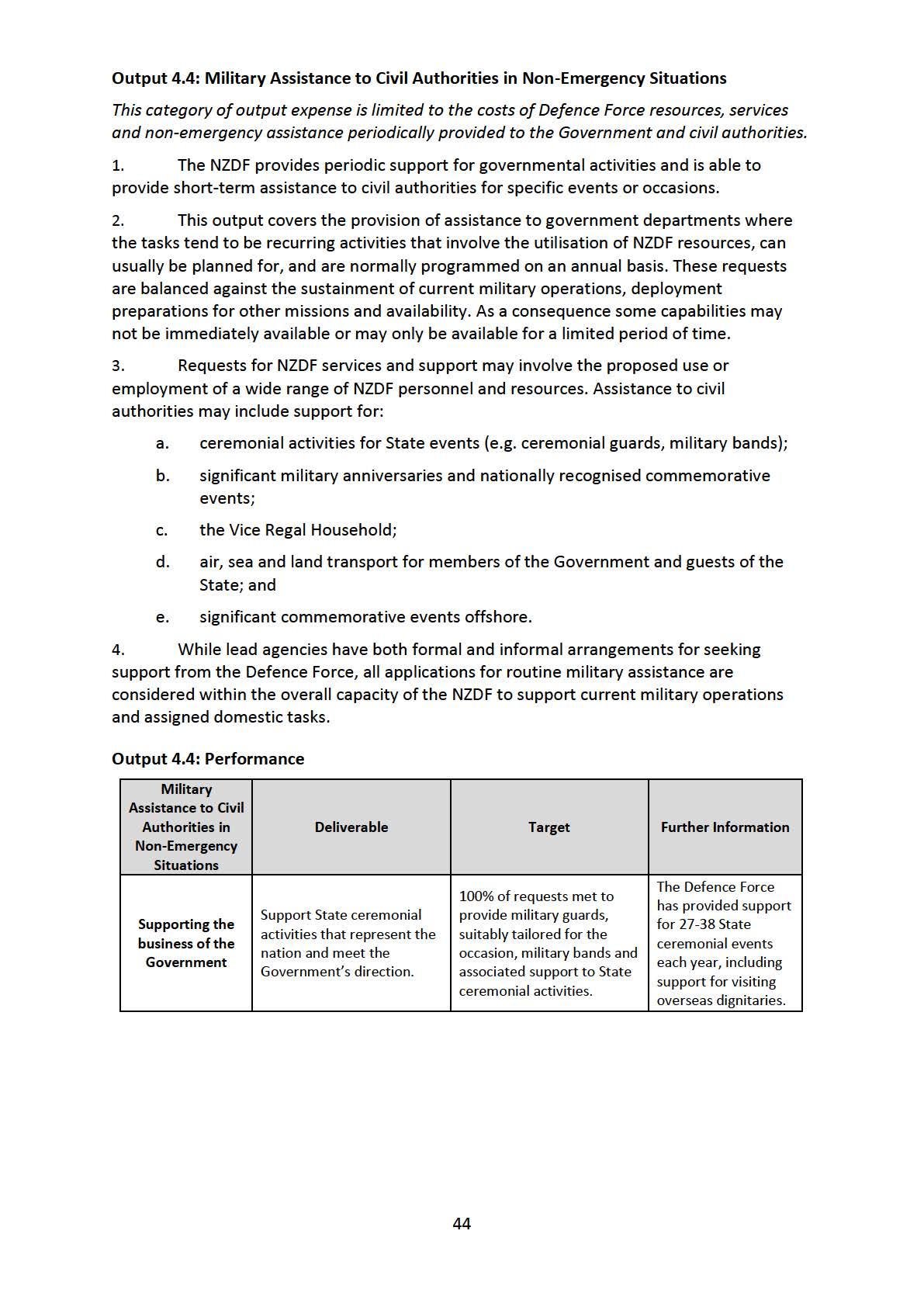
RELEASED UNDER THE OFFICIAL INFORMATION ACT 1982
The Defence Force
provides ceremonial
support for
Anzac Day, Armistice
Day,
100% of requests met to
commemorations
provide military guards,
recognising
suitably tailored for the
significant military
occasion, military bands and events (including
Support significant military
associated support to
wreath-laying
anniversaries and nationally
significant military
ceremonies),
recognised commemorative
anniversaries, nationally
Waitangi Day, Royal
events.
recognised commemorative
and Commonwealth
events and significant
events (e.g. Queen’s
commemorative events
Birthday) and
overseas.
overseas
commemorations
related to the past
deployment of New
Zealand Forces.
100% of requests met to
provide representational
staff for the Vice Regal
The Defence Force
House, military guards,
Support the Vice Regal
has provided support
suitably tailored for the
Household.
for 8 – 10 Vice Regal
occasion, military bands, air, events each year.
land and sea transport and
associated support for Vice
Regal activities.
The Defence Force
100% of requests met to
has provided 190 -
provide air, land and sea
240 flying hours, 6 –
Support the Government’s
transport for members of
10 sea-days and
internal and external
the Government and guests
between 10- 13,000
transportation
of the State to support the
km of land transport
requirements.
Government's internal and
in support of the
external transportation
Government’s
requirements.
requirements each
year.
45
RELEASED UNDER THE OFFICIAL INFORMATION ACT 1982
Output 4.5: Defence Support to the Community
This category of output expense is limited to the costs of providing Defence Force resources
for the betterment of the community at large and to inform the public’s awareness of the
proficiency and practice of the Armed Forces.
1.
The NZDF is able to play an important role in the community and in the process is
able to increase public awareness of NZDF activities and achievements. To fulfil its role in
times of crisis it is important that the public also has a high level of trust and confidence in
the NZDF.
2.
The NZDF is able to support local authorities and communities in a variety of ways.
This help includes:
a.
managing and participation in routine youth and young adult development
programmes;
b.
short-term assistance for special events and those of significant value to the
local communities; and
c.
the preservation of the nation’s military heritage and culture.
3.
Supporting the community promotes national identity, improves civil-military
relations, provides visibility of the role of the Armed Forces, improves recruitment,
enhances the community’s trust in the Defence Force and preserves the military history for
future generations to enjoy.
4.
The Reserve Forces play a key role in delivering support to the community. With
their local base and municipal engagement, the Reserve Forces offer an ideal means of
representing the NZDF in the wider community, encouraging enlistment and supporting
local government and civil contingencies.
5.
In particular, this output covers:
a.
New Zealand Cadet Forces;
b.
Limited Service Volunteer programme (LSV), and Youth Life Skills (Service
Academies);
c.
NZ Police community support programmes (e.g.
Blue Light Trust activities);
d.
Support to the management of Service museums;
e.
Support for Hui of national significance; and
f.
Support for significant national and community events.
46
RELEASED UNDER THE OFFICIAL INFORMATION ACT 1982
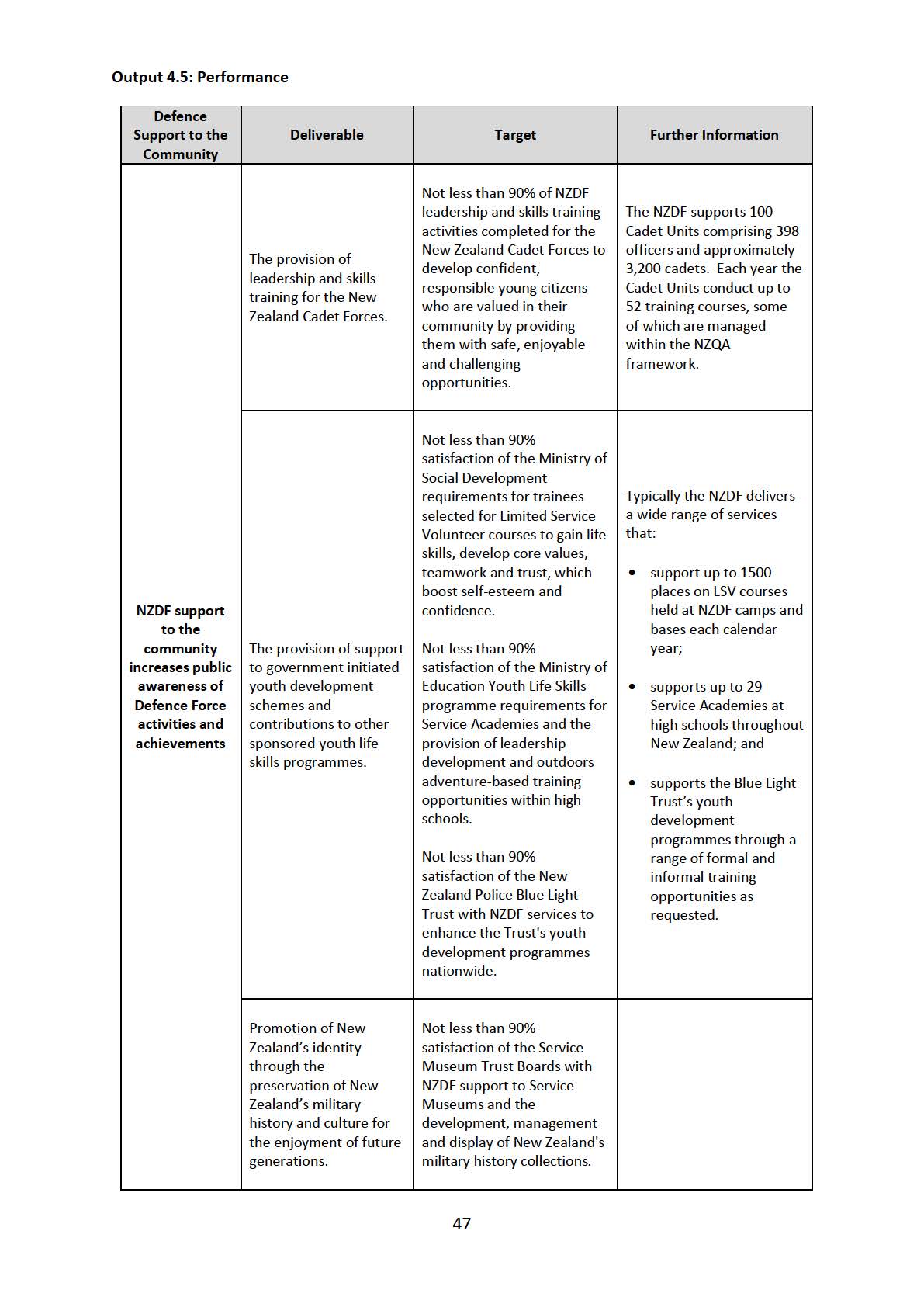
RELEASED UNDER THE OFFICIAL INFORMATION ACT 1982

RELEASED UNDER THE OFFICIAL INFORMATION ACT 1982
OUTPUT CATEGORY 5: PROJECT
Operations Contributing to New Zealand’s Security, Stability and Interests
The single overarching purpose of this appropriation is the employment of New Zealand’s
Armed Forces overseas at the Government’s direction.
1.
This Multi Category Appropriation comprises two discrete outputs.
2.
This Output Class relates to the employment of the Armed Forces in the conduct of
operations for the defence of New Zealand and its approaches and global operations in
accordance with the Government of New Zealand’s policies.
3.
Delivering security, whether at home or abroad, is not the business of any one
government agency. It relies on a comprehensive approach to conflict and insecurity and
demands the coordinated application of the full range of governmental, international and
non-governmental capabilities.
4.
There are a range of contingencies where the Government may commit New
Zealand’s Armed Forces, including humanitarian assistance and disaster relief, evacuation of
New Zealand citizens overseas, peacekeeping, peace enforcement, military assistance to
stabilisation and military interventions (normally as part of a combined international effort).
5.
This Output Class is the primary use of the generation of military combat capability
and the delivery of foreign assistance delivered to the Government through our principal
outputs (Outputs 1 – 3).
6.
It involves the integration and preparation of Force Elements, joint and common
enabling capabilities, deployable command capabilities and the formation of Joint Task
Forces, Task Groups and specialised forces for employment on combat and stabilisation
operations. It also involves a rapid response to a security event or crisis where there is a
need to conduct humanitarian assistance and disaster relief, undertake security duties and
effect non-combatant evacuation operations. Specifically this Output Class is a programme
of activities that:
a.
integrates Force Elements, deployable command capabilities and joint enablers;
assembles and mobilises Joint Task Forces, Task Groups and specialised Force
Elements specific to operational requirements and ensures their means of
deployment, sustainment and recovery in a joint capacity;
b.
generates forces for operational deployment offshore;
c.
commands operationally deployed forces;
d.
employs high readiness forces to conduct regional stabilisation operations at
short notice;
e.
employs military forces on combat and/or stabilisation operations to restore the
international rule of law;
f.
employs a Joint Task Force or components thereof in response to a regional or
international crisis or major disaster;
g.
employs Reserve Force specialists for military operations and other tasks; (these
multi-discipline capabilities may include: medical, civil engineering, linguists,
specialists capable of helping a nation rebuild its governance and infrastructure);
h.
supports the Government’s efforts to evacuate New Zealand citizens from high-
risk environments; and
49
RELEASED UNDER THE OFFICIAL INFORMATION ACT 1982
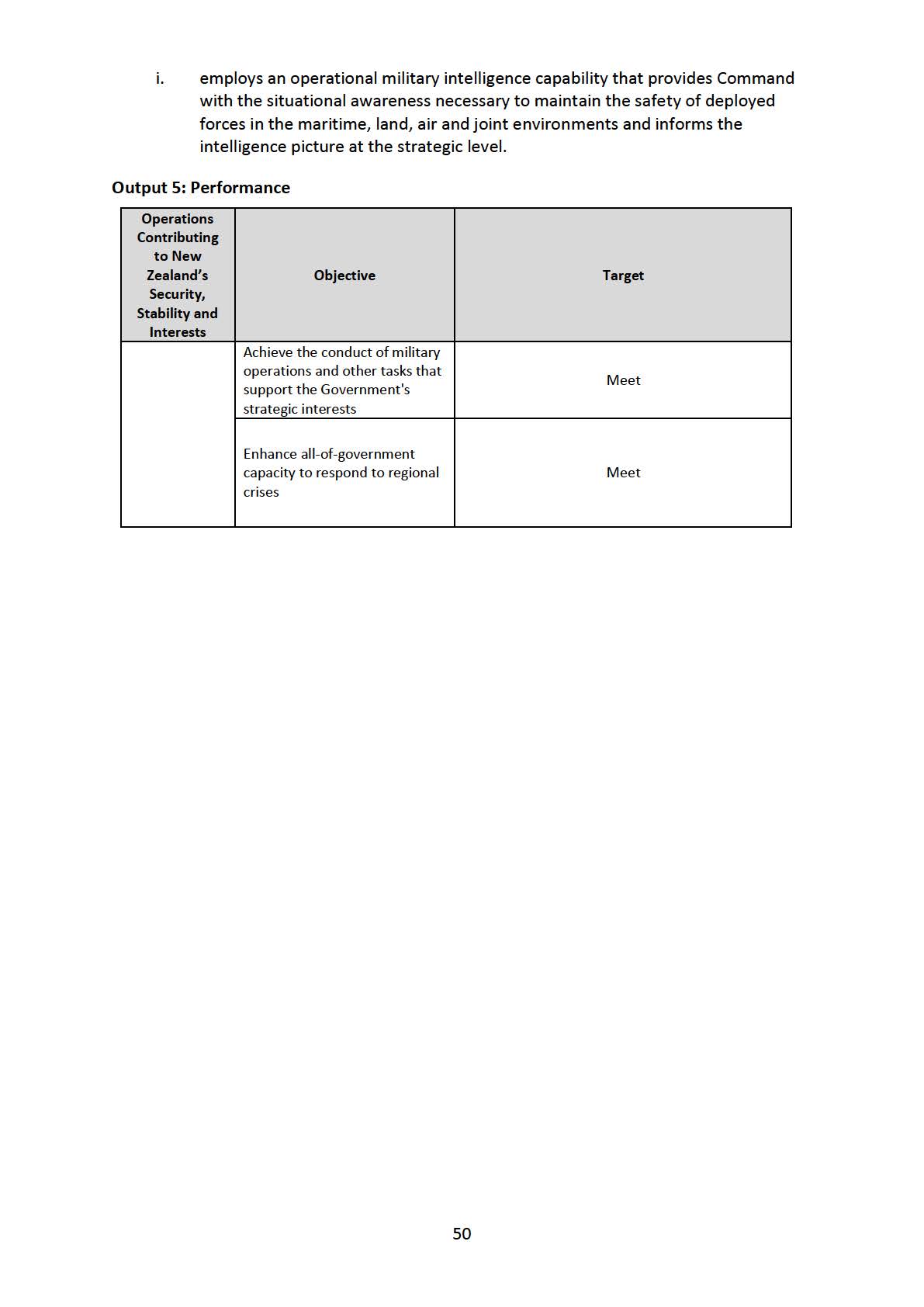
RELEASED UNDER THE OFFICIAL INFORMATION ACT 1982
Output 5.1: Military Operations in support of a Rules-Based International Order
This category of output expense is limited to the costs of generating operational military
capabilities and the employment of New Zealand Armed Forces for the conduct of
operations, as directed by the Government.
1.
This Output Class represents the main use of Outputs 1 – 3; the generation of
military capabilities. It makes provision for the employment of forces on operations both
independently and in conjunction with security partners, whether on an enduring basis,
selective on-going operations or as required for named international operations.
2.
When directed by the Government, this output contributes to global peace and
security through the conduct of military operations across the spectrum of conflict from
humanitarian assistance to combat, in conjunction with national and international partners,
to achieve timely and decisive results in support of New Zealand’s national interests.
51
RELEASED UNDER THE OFFICIAL INFORMATION ACT 1982
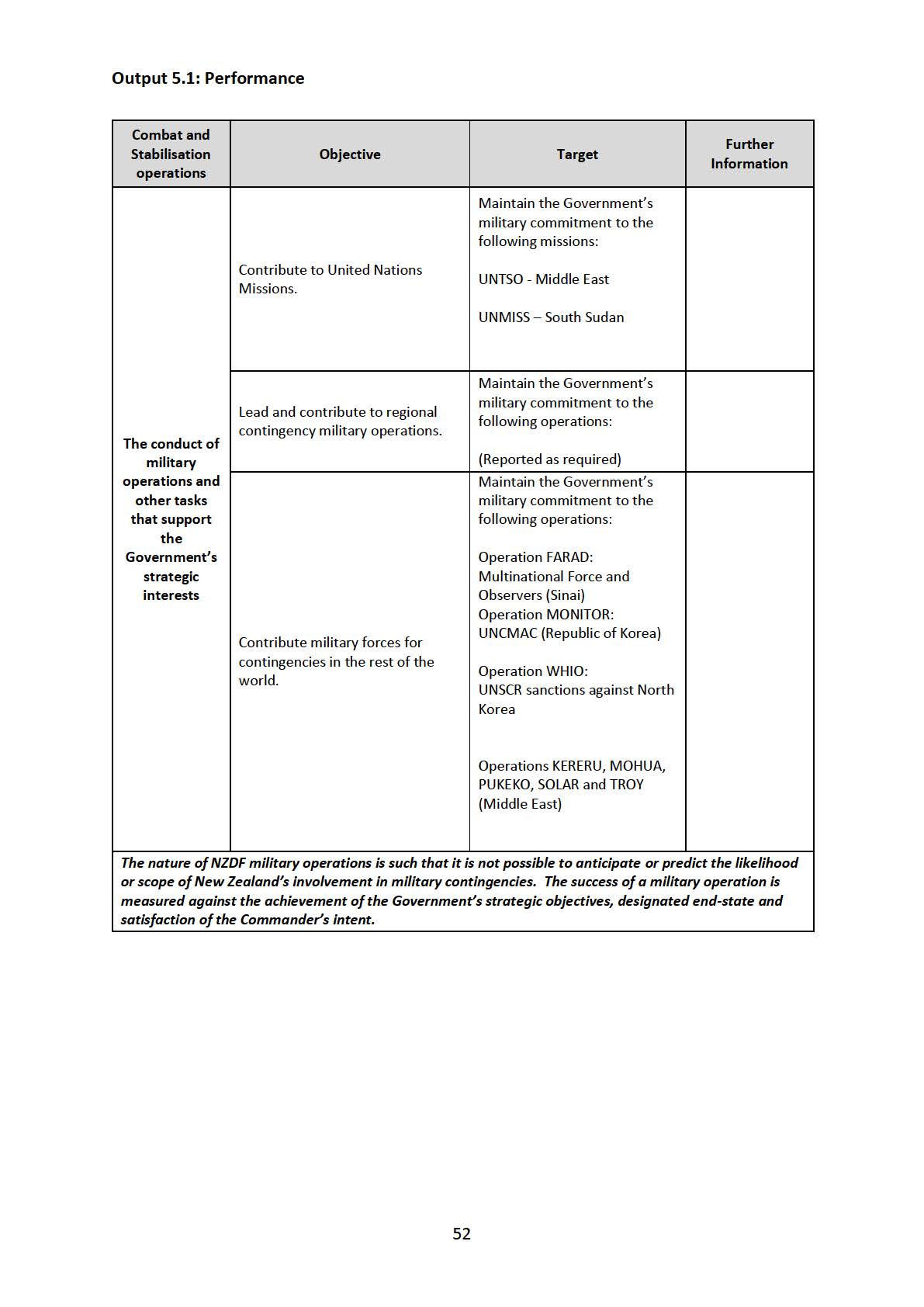
RELEASED UNDER THE OFFICIAL INFORMATION ACT 1982
Output 5.2: Military Operations that Contribute to Regional Security
This category of output expense is limited to the costs of providing specialised support to all-
of-government efforts to maintain security and stability in New Zealand’s immediate
neighbourhood including responses to events that impact on the safety and wellbeing of
regional populations, as directed by the Government.
1.
This is the availability of components of the NZDF to respond rapidly to regional
security events, especially those events that demand a response for humanitarian assistance
and disaster relief and when it becomes necessary to support all-of-government efforts to
evacuate New Zealand citizens from high-risk areas. The NZDF High-Readiness capability
allows the NZDF to react rapidly to regional crises. This includes contributions to the Anzac
Ready Response Force and a range of capable maritime, land (including special operations)
and air capabilities that enable New Zealand to act alone or in a combined response with
regional partners.
2.
While the NZDF is not the primary government means of providing assistance, it
can be tasked to supplement or complement the efforts of a host nation’s civil authorities or
agencies that may have the primary responsibility for providing that assistance. The NZDF
has unique assets for effective response and can play a key role in humanitarian crises. For
example, it possesses exceptional operational reach that can be employed to enhance an
initial response. Furthermore, the NZDF’s unmatched capabilities in command and control,
communications, intelligence, logistics, and mobility are able to provide rapid and robust
response to civilian and government entities in dynamic and evolving situations.
53
RELEASED UNDER THE OFFICIAL INFORMATION ACT 1982

RELEASED UNDER THE OFFICIAL INFORMATION ACT 1982
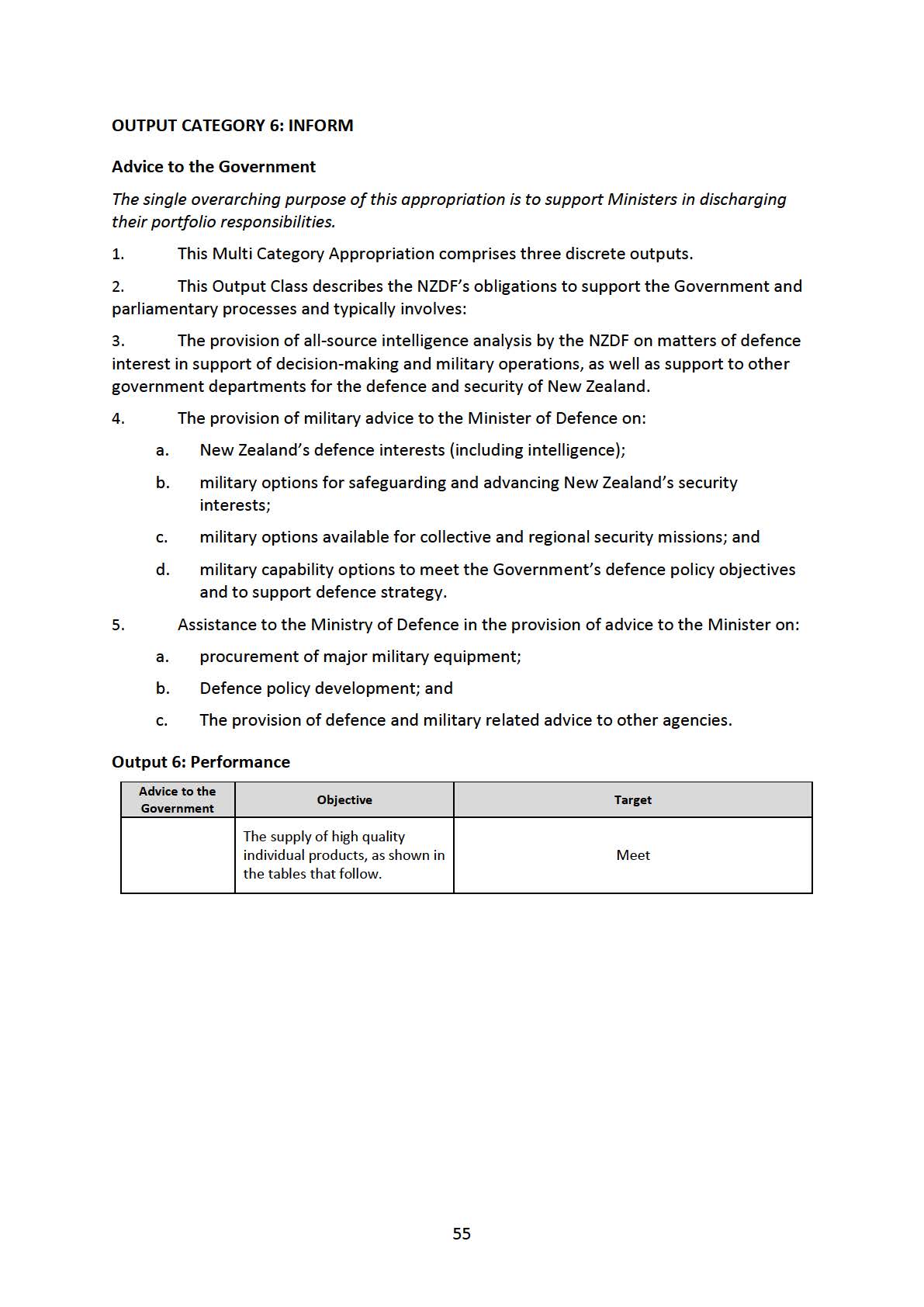
RELEASED UNDER THE OFFICIAL INFORMATION ACT 1982
Output 6.1: Policy Advice
This category of output expense is limited to the provision of advice (including second
opinion advice and policy advice led by other agencies) to support decision-making by
Ministers on Government policy matters relating to defence and the NZDF.
1.
The Chief of Defence Force, as the principal military adviser, provides the
Government and government departments and agencies with quality and timely advice on
military matters as the basis for well-informed decision-making.
2.
This policy advice, including second opinion advice and contributions to policy
advice led by other agencies, supports decision-making by Ministers on Government policy
relating to defence and the NZDF. The preparation of military policy advice for the CDF is
generally produced by teams who have a wide range of other duties and is not necessarily
the sole responsibility of one directorate.
3.
While the Ministry of Defence has the principal responsibility for defence policy
matters, the NZDF has specific responsibilities for defence policy matters relating to
strategic military intelligence, defence international engagement (defence diplomacy) and
military capability development.
56
RELEASED UNDER THE OFFICIAL INFORMATION ACT 1982
Output 6.2: Situational Awareness
This category of output expense is limited to the provision of effective military intelligence
services to the Government in support of decision-making for the defence and security of
New Zealand.
1.
The New Zealand Government and the Defence Force require an accurate and
timely security picture, comprehensive situational awareness and threat knowledge for the
defence and security of New Zealand and its strategic interests elsewhere. This output
provides credible, reliable, and sustained support to the Government’s decision-making and
other government departments for the defence and security of New Zealand as well as
advice relating to the conduct of military operations under consideration by the
Government.
2.
The NZDF also works as an integrated partner in the broader New Zealand
intelligence sector and responds to the direction and priorities of the Government’s national
security system, supporting all-of-government activities such as counter-terrorist operations
and sovereignty enforcement.
3.
The Department of Prime Minister and Cabinet coordinates the activities of the
various security and intelligence agencies providing for the security and safety of New
Zealanders. The NZDF supports these national security outcomes and other defence
outputs through contributions to national security and intelligence assessments.
57
RELEASED UNDER THE OFFICIAL INFORMATION ACT 1982

RELEASED UNDER THE OFFICIAL INFORMATION ACT 1982
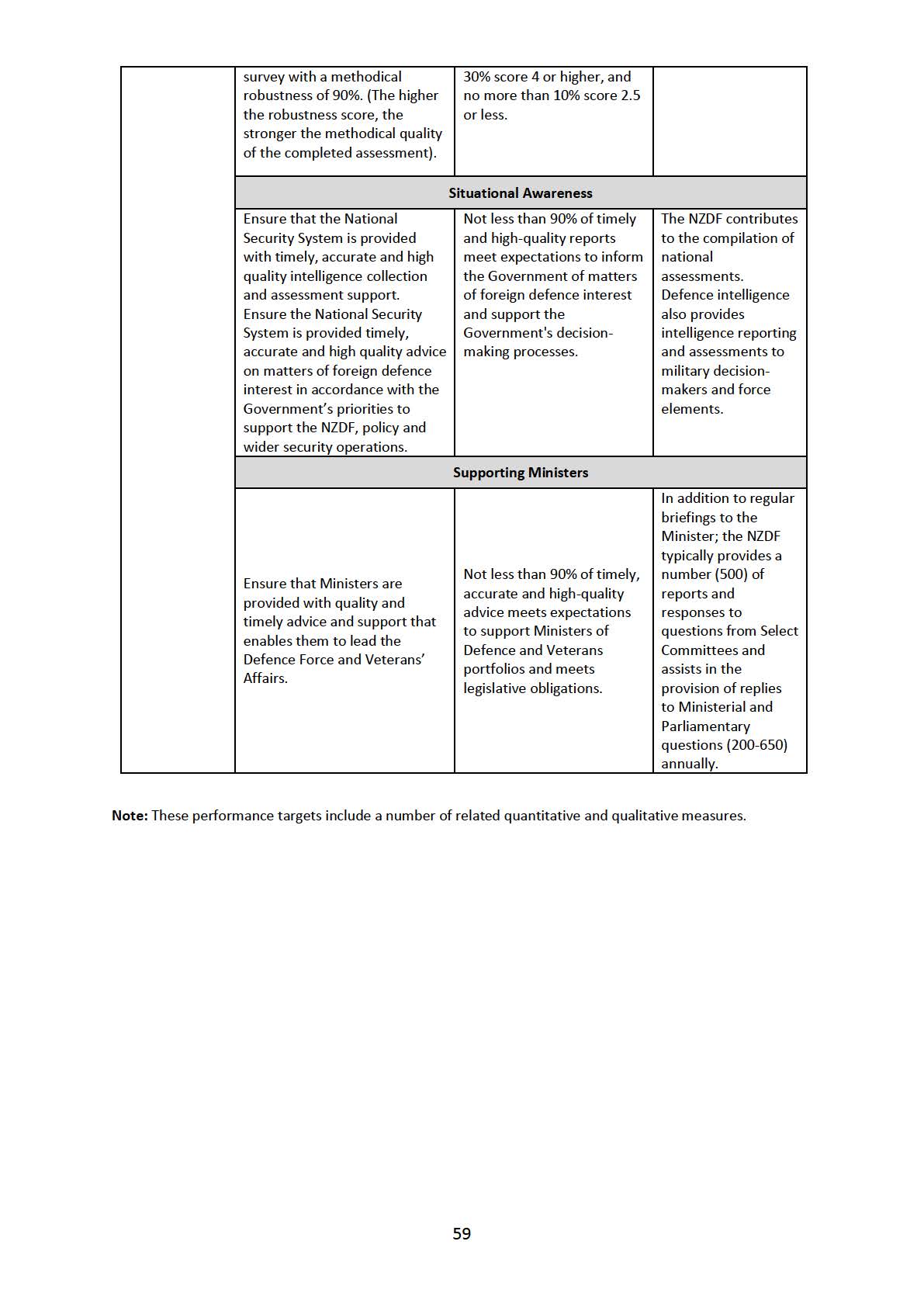
RELEASED UNDER THE OFFICIAL INFORMATION ACT 1982
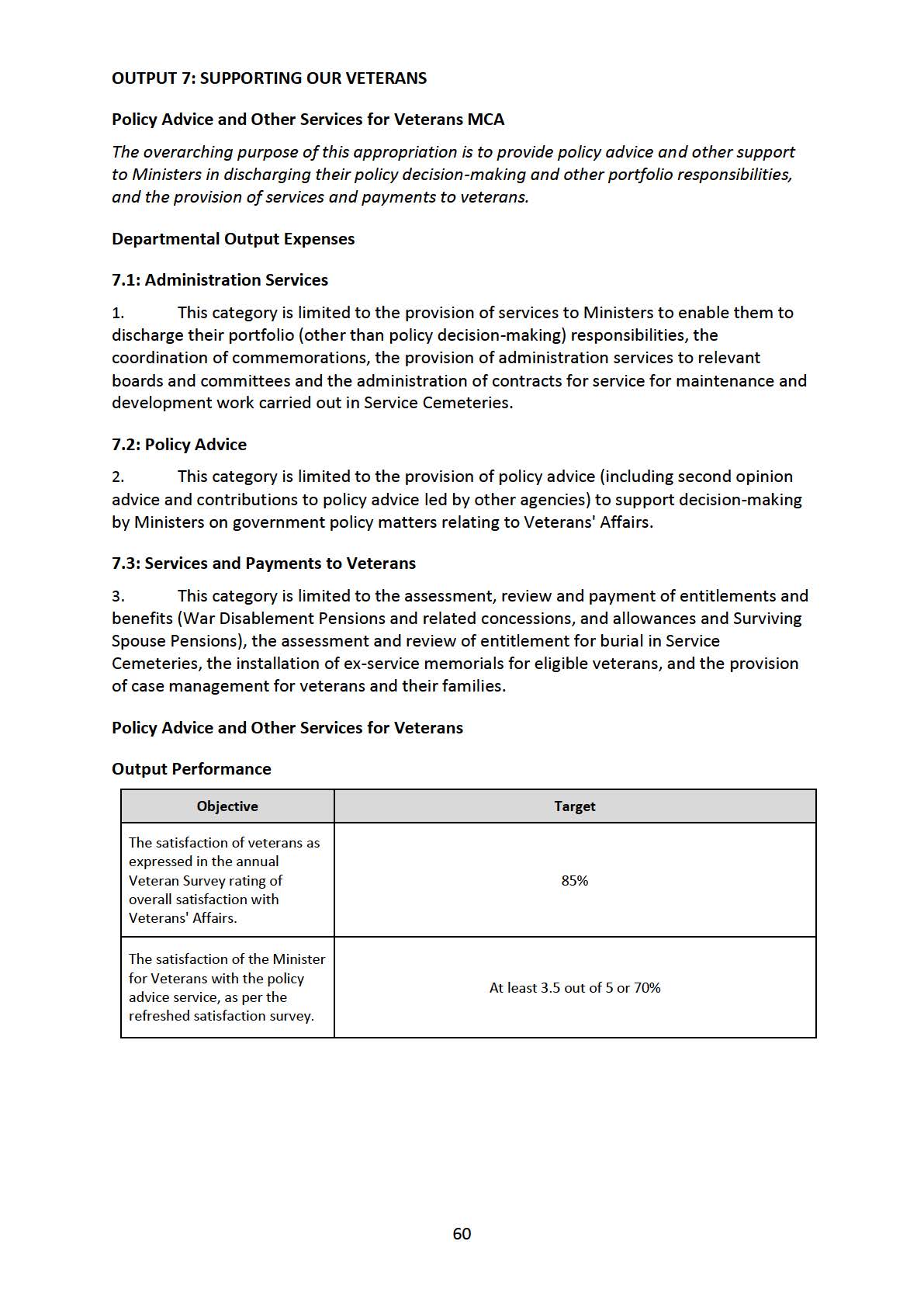
RELEASED UNDER THE OFFICIAL INFORMATION ACT 1982
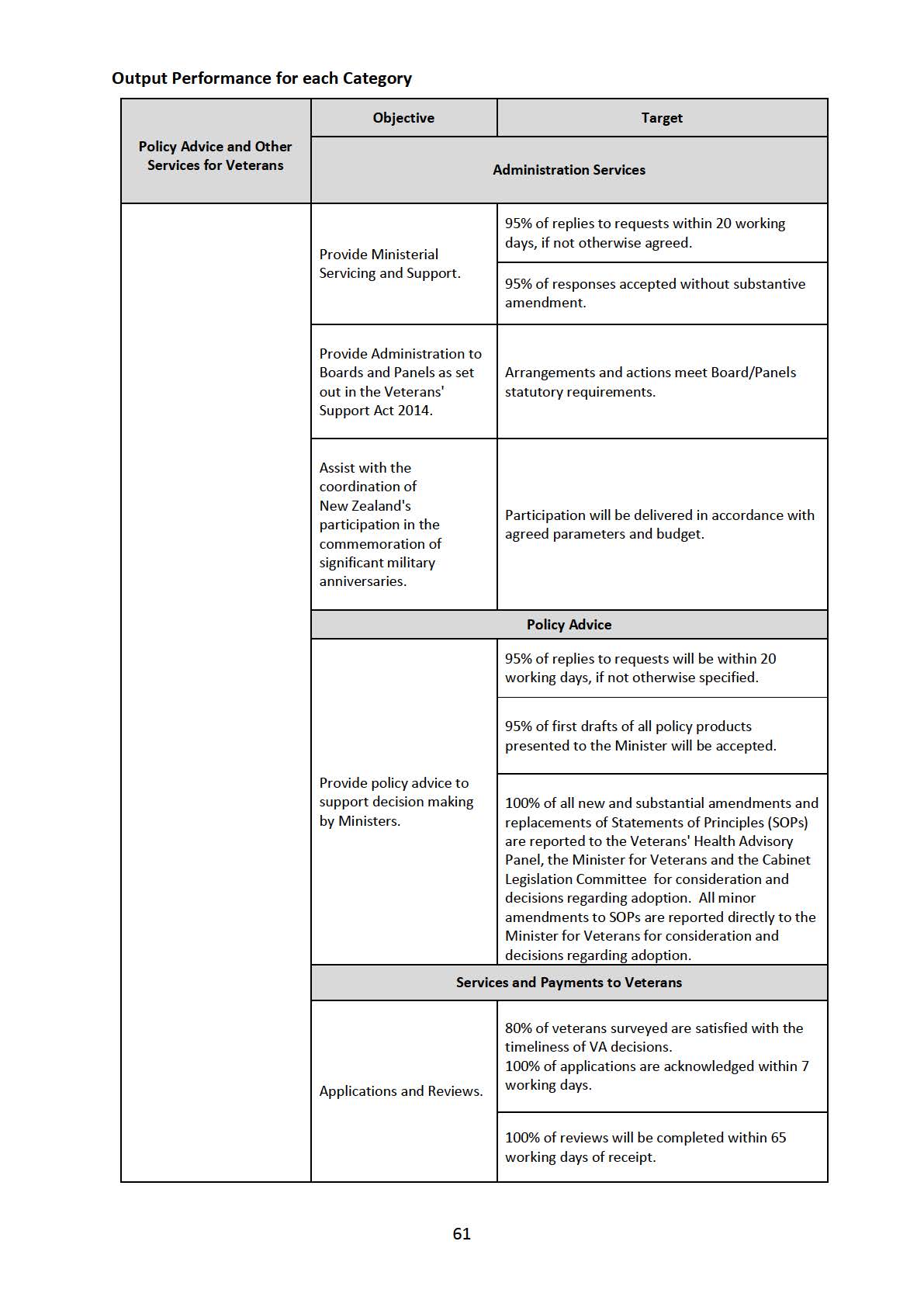
RELEASED UNDER THE OFFICIAL INFORMATION ACT 1982
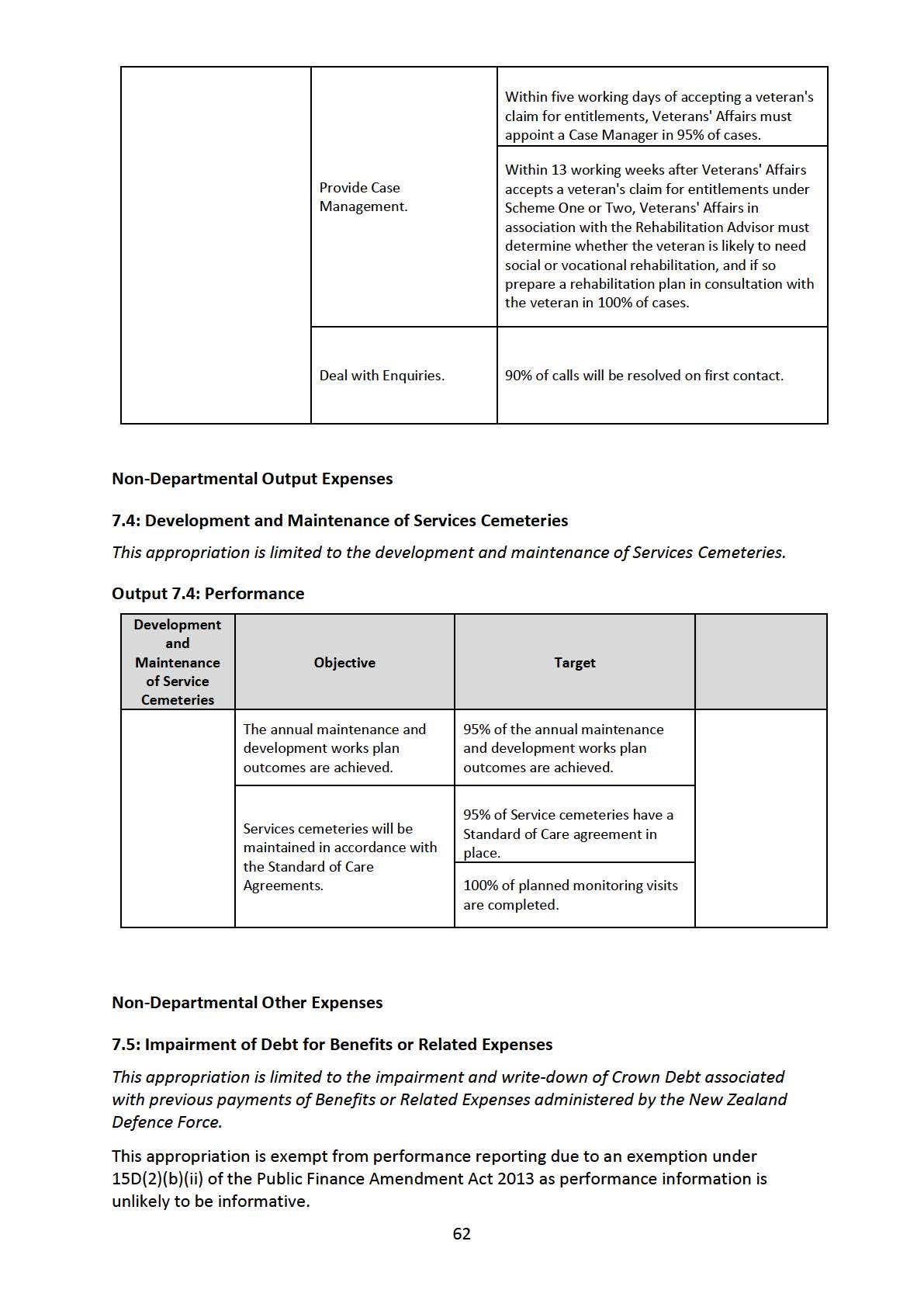
RELEASED UNDER THE OFFICIAL INFORMATION ACT 1982
7.6: Support for Vietnam Veterans
This appropriation is limited to annual comprehensive medical assessments for Vietnam
veterans, the monitoring of trends in the health and wellbeing of Vietnam veterans and
providing this information to veterans, and ex gratia payments to Vietnam veterans and/or
members of their family with accepted conditons.
This appropriation is exempt from performance reporting due to an exemption under
15D(2)(b)(iii) of the Public Finance Amendment Act 2013 as the amount for this annual
appropriation is less than $5 million.
7.7: Fair Value Write Down on Veteran Trust Loans and Thirty-Year Endowment
This appropriation is limited to providing for the fair value write down on the Veteran Trust
loans and the thirty-year endowment to the Vietnam Veterans and their Families Trust.
This appropriation is exempt from performance reporting due to an exemption under
15D(2)(b)(ii) of the Public Finance Amendment Act 2013 as performance information is
unlikely to be informative.
7.8: Veteran Assistance to Attend Commemorations and Revisit Battlefields
This appropriation is limited to providing assistance to veterans to enable them to attend
official commemorations or revisit battlefields.
This appropriation is exempt from performance reporting due to an exemption under
15D(2)(b)(iii) of the Public Finance Amendment Act 2013 as the amount for this
appropriation is less than $5 million.
7.9: Grant Payments to Non-Government Organisations
This appropriation is limited to grant payments to Non-Government Organisations in their
support of veterans and their families.
This appropriation is exempt from performance reporting due to an exemption under
15D(2)(b)(iii) of the Public Finance Amendment Act 2013 as the amount for this
appropriation is less than $5 million.
7.10: Service Cost – Veterans’ Entitlements
This appropriation is limited to the present value of entitlements resulting from qualifying
service or qualifying operational service in the current year or prior years, provided for under
Parts 3, 4 and 5 of the Veterans’ Support Act 2014, and annuities authorised by Cabinet to
recognise a special contribution by the recipient to New Zealand society as part of their
qualifying service or qualifying operational service.
This appropriation is exempt from performance reporting due to an exemption under
15D(2)(b)(ii) of the Public Finance Amendment Act 2013 as performance information is
unlikely to be informative.
7.11: Unwind of Discount Rate – Veterans’ Entitlements
This appropriation is limited to the unwinding of the discount rate (interest expense) of the
liability for the Veterans’ entitlements provided for under Parts 3, 4 and 5 of the Veterans’
Support Act 2014, and annuities authorised by Cabinet to recognise a special contribution by
63
RELEASED UNDER THE OFFICIAL INFORMATION ACT 1982
the recipient to New Zealand society as part of their qualifying service or qualifying
operational service.
This appropriation is exempt from performance reporting due to an exemption under
15D(2)(b)(ii) of the Public Finance Amendment Act 2013 as performance information is
unlikely to be informative.
64
RELEASED UNDER THE OFFICIAL INFORMATION ACT 1982














































